


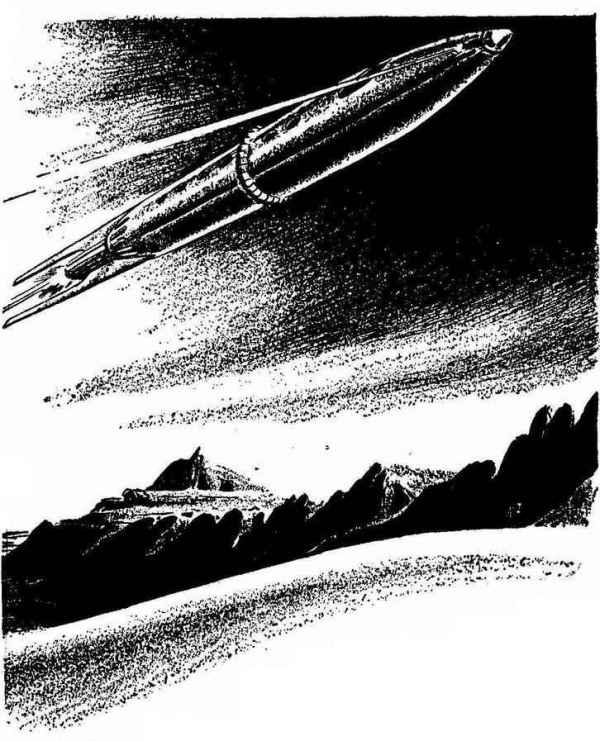




May 21, 1945: From this day’s interview of Albert Speer by the US Strategic Bombing Survey Team:
Just like you in America, our scientists have been studying the smashing of the atom. You are more advanced in America; you have the large cyclotrons. I have supported it during my tenure and have built several small cyclotrons, one of which is in Heidelberg. According to my opinion we were far behind your men in America.
1945 Science Fact Article
: Journey Into Space.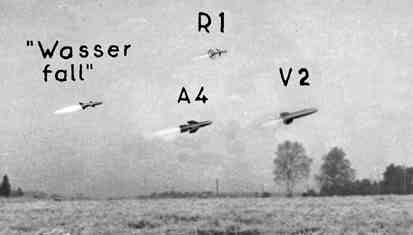
June 1, 1945: A Soviet trophy brigade arrives at Peenemünde. They discover an extraordinary variety of weapons systems that the Americans had left behind, including ten partially assembled V-2s, and a few Wasserfall, Rheinbote, Rheintochter, and Taifun missiles. (Menaul)
June 5, 1945: The Allies divide up Germany and Berlin and take over the government.
June 20, 1945: US Secretary of State Cordell Hull approves the transfer of von Braun and his specialists to America, but it will not be announced to the public until the first of October.
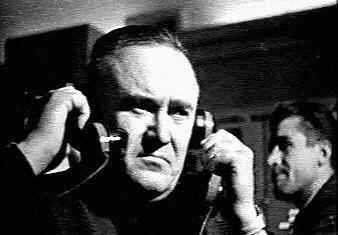
June 1945: General Eisenhower sanctions a series of V2 test launches in Europe. Among those witnessing the flights is the future chief Soviet spacecraft designer, Sergei Korolev. (Harford)
July 17–August 2, 1945: At the Potsdam Conference, it is decided that there will, for the foreseeable future, be a ban in Germany on carrying out rocket technology research. Any remaining V2s and their production sites are to be removed and relocated to the US and Soviet Union, respectively. Engineers and skilled technicians involved in rocket research are also to be deported. (Menaul)
July 19, 1945: The US JCS initiates a program detailing the handling of the Nazi scientists and their families. Labeled initially Operation Overcast, it will soon be renamed Operation Paperclip.
August 3, 1945: Stalin decrees that an interagency commission on the V-2 be empowered to recruit experts from various Soviet industries to jump-start a Soviet rocket program. (Menaul)

August 6, 1945: The United States drops an atomic bomb on Hiroshima.
August 8, 1945: Many Soviet scientists suddenly find themselves unwillingly made members of the "Inter-ministerial Commission" and sent to Berlin. There, they tour German plants and facilities, advising on what should be shipped back to the USSR and what should be destroyed. (Menaul)
August 8, 1945: The Soviets declare war on Japan and invade Manchuria.
August 9, 1945: Reconstruction of a captured V-2 with the help of 150 German specialists begins as a group of 284 Russian scientists arrive in Berlin. (Menaul)
August 10, 1945: Robert Hutchings Goddard dies of throat cancer in Baltimore, Maryland. He is buried in Hope Cemetery in his hometown of Worcester, Massachusetts. Goddard was credited with 214 patents for his work; 131 of these were awarded after his death.
From Robert Goddard: Space Pioneer by Anne Perkins Dewey: Dr. Goddard's final project at Annapolis was a small, pressure-fed liquid-oxygen gasoline rocket, possibly adaptable to a small guided missile. His exhausting work schedule began to affect his health, and brought back symptoms that seemed at first to point to his old lung trouble. For a time, he stubbornly kept on working despite a constant cough. Then after a while it became painful even to speak, and as much as possible he wrote out what he wanted to say. By the time his doctors persuaded him that he must go to the hospital, he seemed almost indifferent—too tired to care . . . .
When the doctors operated, they found that cancer had attacked a larynx already weakened by the long-ago battle with tuberculosis. They hoped he could be made strong enough to withstand a second operation, but despite blood transfusions he grew more feeble.
Late one stifling night in August, when Mrs. Goddard had barely reached home from the day at her husband's bedside, a call came from the hospital. The night nurse said that Dr. Goddard seemed very restless and disturbed. He wanted his wife to come back at once, as there was something he must tell her. Hurrying back to the hospital, she found him too weak to speak. He recognized her, smiled, and fell back on the pillow, exhausted.
"I thought this might happen," whispered the nurse. "A little while after I called you I could see he was already too tired to talk. But he showed me he wanted his writing pad when I asked what he needed to see you about." Mrs. Goddard took the note pad and read the words: 'About a thousand things!'
August 15, 1945: Proclamation of V-J Day.
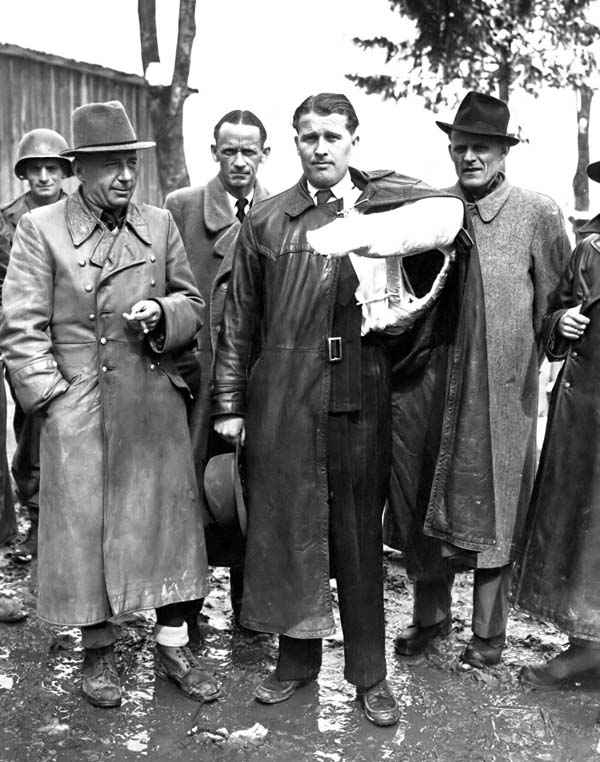
September 18, 1945: Wernher von Braun, (suffering from hepatitis that he probably contracted through treatment for his broken arm), and six other German rocket experts arrive under guard at Newcastle Army Air Base in Wilmington, Delaware. (Piszkiewicz)
September 18, 1945: Wernher von Braun and the other rocket experts are loaded aboard a DC-3, and transferred to Boston's Logan Field. From there they are taken to Fort Strong, Long Island, for processing and interrogation. (Piszkiewicz)
From Vanguard: A History by Constance McLaughlin Green and Milton Lomask: The haughtiness of the Germans who landed at Wright Field in the autumn of 1945 was not endearing to the Americans who had to work with them. The Navy wanted none of them, whatever their skills. During a searching interrogation before the group left Germany, a former German general had remarked testily that, had Hitler not been so pig-headed, the Nazi team might now be giving orders to American engineers . . . . The American scientist conducting the questioning growled in reply that Americans would never have permitted a Hitler to rise to power.
September 20, 1945: The first seven German technicians arrive in the United States at New Castle Army Air Field.
September 30, 1945: From the Summary Report of the US Strategic Bombing Survey:
The jet planes, especially the ME-262, were the most modern planes which any belligerent had in general operation at the end of the war. According to manufacturers and other competent observers, their production was delayed because of the failure of the Luftwaffe to recognize in time the advantages of the type. It was also delayed because Hitler intervened in 1944 with an ill-timed order to convert the ME-262 to a fighter-bomber. Virtually every manufacturer, production official, and air force general interrogated by the Survey, including Goering himself, claimed to have been appalled by this order. By May 1945, 1,400 jets had been produced. Had these planes been available six months earlier with good quality pilots, though they might not have altered the course of the war, they would have sharply increased the losses of the attacking forces . . . .
Among the most significant of the other factors which contributed to the success of the air effort was the extraordinary progress during the war of Allied research, development, and production. As a result of this progress, the air forces eventually brought to the attack superiority in both numbers and quality of crews, aircraft, and equipment. Constant and unending effort was required, however, to overcome the initial advantages of the enemy and later to keep pace with his research and technology. It was fortunate that the leaders of the German Air Force relied too heavily on their initial advantage. For this reason they failed to develop, in time, weapons, such as their jet-propelled planes, that might have substantially improved their position. There was hazard, on the other hand, in the fact that the Allies were behind the Germans in the development of jet propelled aircraft. The German development of the V weapons, especially the V-2, is also noteworthy . . . .
Speed, range, and striking power of the air weapons of the future, as indicated by the signposts of the war in Europe must—specifically—be reckoned with in any plans for increased security and strength. The combination of the atomic bomb with remote-control projectiles of ocean-spanning range stands as a possibility which is awesome and frightful to contemplate.
October 1, 1945: The US War Department announces in a Press Release: OUTSTANDING GERMAN SCIENTISTS BEING BROUGHT TO US.
The Secretary of War has approved a project whereby certain outstanding German scientists and technicians are being brought to this country, to ensure that we take full advantage of those significant developments [that] are deemed vital to our national security.
Interrogation, and examination of documents, equipment, and facilities--in the aggregate--are but one means of exploiting German progress in science and technology. In order that this country may benefit fully from this resource, a number of carefully selected scientists and technologists are being brought to the United States, on a voluntary basis. These individuals have been chosen from those fields, where German progress is of significant importance to us and, in which, these specialists have played a dominant role.
Through their temporary stay in the United States, these German scientists and technical experts will be under the supervision of the War Department, but will be used for appropriate military projects of the Army and Navy.
October 1, 1945: Wernher von Braun arrives at Fort Bliss--in El Paso, Texas--in the custody of Major James P. Hamill. Hamill's assignment is to head the first US guided-missile program; and von Braun and the other six German rocket scientists are his first seven workers. Fort Bliss is just 35 miles from the White Sands launch site, which is located 120 miles southeast of Robert H. Goddard's old launch site at Roswell. (Piszkiewicz)
October 2, 1945: Having acquired a number of intact V-2s, the British attempt to test-fire one near the town of Cuxhaven, Germany. The test is a complete failure due to ignition problems, [the rocket] never leaving the ground. (Piszkiewicz)
October 3, 1945: The British successfully test-fire a V-2 at Cuxhaven, burning for nearly 5 minutes, and missing the target by a mile and a half. (Piszkiewicz)
October 4, 1945: The British successfully test-fire a second V-2 at Cuxhaven, but it only burns for 30 seconds, and falls far short of its target. (Piszkiewicz)
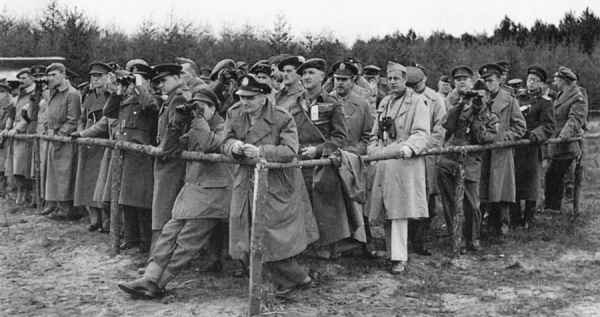
October 15, 1945: The USSR sends six Soviet representatives, including Sergey Korolyov, to witness the third, and last, British demonstration launch of a V-2 at Cuxhaven. The British had invited each Ally to send three observers to witness their test firing of a V-2. The Soviets sent six, not three. The British only admitted the allowed three into the facility to witness the test, forcing the other three to try to see, from outside, what was going on. (Piszkiewicz)
December 1945: 600 German and Soviet specialists are now at work at the Zentralwerke in Bleicherode. (Menaul)
February 23, 1946: The last 117 German rocket scientists recruited under Operation Overcast arrive in El Paso. Twelve of them will be housed at White Sands, while the rest will reside at Fort Bliss. The group, now reunited for the first time since the evacuation of Peenemuende, will be commonly referred to collectively as 'The Team.' They have arrived in the US without their families, who are being kept in Camp Overcast in Bavaria. (Piszkiewicz)
1946 Science Speculation Article: Aviation of Tomorrow.
March 5, 1946: Winston Churchill introduces the phrase Iron Curtain into the English language (the term was originally coined by Josef Goebbels) during his famous Cold War speech at Fulton, Missouri.
If now the Soviet Government tries, by separate action, to build up a pro-Communist Germany in their areas, this will cause new serious difficulties in the British and American zones, and will give the defeated Germans the power of putting themselves up to auction between the Soviets and the Western Democracies. Whatever conclusions may be drawn from these facts—and facts they are—this is certainly not the Liberated Europe we fought to build up. Nor is it one which contains the essentials of permanent peace...
March 13, 1946: Operation Overcast changes its name to Operation Paperclip. (Piszkiewicz)
March 14, 1946: Stalin speaks in response to Churchill's Iron Curtain speech:
The German racial theory brought Hitler and his friends to the conclusion that the Germans, as the only fully valuable nation, must rule over other nations. The English racial theory brings Mr. Churchill and his friends to the conclusion that nations speaking the English language, being the only fully valuable nations, should rule over the remaining nations of the world . . . .
As a result of the German invasion, the Soviet Union has irrevocably lost in battles with the Germans, and also during the German occupation and through the expulsion of Soviet citizens to German slave labor camps, about 7,000,000 people. In other words, the Soviet Union has lost in men several times more than Britain and the United States together. It may be that some quarters are trying to push into oblivion these sacrifices of the Soviet people...
From the National Historic Landmark summary listing of the US National Park Service: This site is closely associated with U.S. testing of the German V-2 rocket, the origins of the American rocket program, and the leadership of Dr. Werner von Braun (1912-1977). The V-2 Gantry Crane and Army Blockhouse here represent the first generation of rocket testing facilities that would lead to US exploration of space.
March 15, 1946: A V-2 is static-fired at White Sands.
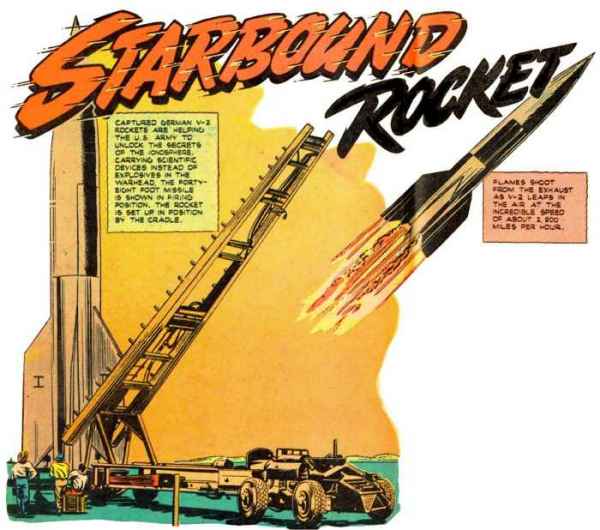
April 16, 1946: For the first time in the United States (at White Sands), a captured German V-2 rocket undergoes a test flight. (Braun)

1946 Science Fact Article: Spaceship Take-Off.
May 1946: 330 German specialists are now working for the Soviet rocket program. (Menaul)
1946 Science Speculation Article: Satellite Space Ship Station.

May 10, 1946: A captured German V-2 rocket achieves high-altitude space flight at White Sands Proving Ground, reaching an altitude of 70 miles. (Braun)
1946 Science Speculation Strip: Jet Planes, Aircraft of the Future.
May 12, 1946: The Rand Project, a part of the Douglas Aircraft Corporation that will eventually become the Rand Corporation, outlines a proposal to the Air Material Command for a 500-pound satellite to be launched by a rocket based on the V-2. They recommend that the satellite contain meteorological research, communications, and reconnaissance equipment, and estimate that the cost will be around 150 million dollars. (Piszkiewicz)
May 13, 1946: A secret Soviet decree creates a varied series of new research institutes devoted to missile development. (Menaul)

May 22, 1946: A Wac Corporal, the first post-war American-designed rocket, makes its first flight, reaching an altitude of 50 miles.
1946 Science Speculation Strip: First Trip to the Moon.
May 29, 1946: A fourth captured V-2 is test fired at White Sands, but the gyroscopic guidance system malfunctions, causing the rocket to crash land on a cemetery hillside south of Juarez, Mexico. While the Mexican authorities were very understanding about the incident, the publicity it generated caused a bit of a boom for local entrepreneurs, who made some quick pesos selling unidentifiable metal fragments--many of which looked suspiciously like tin cans—from roadside stands across the Rio Grande. One lieutenant boasted that he was part of the first United States Army unit to fire a guided missile against a foreign country. (Piszkiewicz)
July 3, 1946: A report found in the so-called Russian Archives written by Ivan Serov, the chief of Soviet security in Germany, reveals that 18 German rocket scientists have been found among inmates of the Gulag. The document details steps to be taken for their release in order that they may make a contribution to Soviet rocketry.
July 4, 1946: Georg Rickhey, former general director of the Mittelwerk factory, arrives in the US as an Operation Paperclip specialist, in the employ of the Army Air Force.
August 9, 1946: The Soviets decide to begin domestic production of new V-2 rockets at a Soviet facility in Podlipki, near Moscow. (Menaul)
August 30, 1946 Nuremberg Tribunal: On day 216 of the historic trial, time is set aside for the defendants to make a final statement before judgment and sentencing. Warning against what he calls the "totalitarian system in the period of modern technical development," Albert Speer uses this opportunity to lecture the world:
But, if a modern industrial state utilizes its intelligence, its science, its technical developments, and its production for a number of years in order to gain a lead in the sphere of armament, then even with a sparing use of its manpower it can, because of its technical superiority, completely overtake and conquer the world, if other nations should employ their technical abilities during that same period on behalf of the cultural progress of humanity.
The more technical the world becomes, the greater this danger will be, and the more serious will be an established lead in the technical means of warfare. This war ended with remote-controlled rockets, aircraft traveling at the speed of sound, new types of submarines, torpedoes which find their own target, with atom bombs, and with, the prospect of a horrible kind of chemical warfare. Of necessity the next war will be overshadowed by these new destructive inventions of the human mind.
In 5 or 10 years the technique of warfare will make it possible to fire rockets from continent to continent with uncanny precision. By atomic power it can destroy one million people in the center of New York in a matter of seconds with a rocket operated, perhaps, by only 10 men, invisible, without previous warning, faster than sound, by day and by night . . . .
September 1946: 5,000 laborers are now employed in construction of new V-2 rockets throughout the Soviet occupation zone. (Menaul)
From Living America by Norman C. Lumian: The moves which the Soviets made at the end of the war gave some indication of how difficult it would be to deal with the Russians in a peacetime situation. Basically, Russia wished to retain the economic and political domination of those nations in her power, while causing great confusion in others. The Russians had indicated that they wished to strip Germany and her allies of their industrial equipment at the Potsdam Conference of July 1945. This would render the Axis powers less able to make war again. Germany and the others would be turned into agricultural nations.
Russia carried out her desires with a vengeance in East Germany. The United States, England, and France—the controlling nations of West Germany—soon saw the folly of this plan which would leave the Germans with very little to support themselves. By the end of May 1946, the United States had given up the policy of dismantling German industry, and in September started to rebuild her enemies' shattered nation.
September 30, 1946 Nuremberg Tribunal: On the penultimate day of the historic trial, the final judgments are read in open court:
He [Speer] also used concentration camp labor in the industries under his control. He originally arranged to tap this source of labor for use in small out-of-the-way factories; and later, fearful of Himmler's jurisdictional ambitions, attempted to use as few concentration camp workers as possible. Speer was also involved in the use of prisoners of war in armament industries, but contends that he only utilized Soviet prisoners of war in industries covered by the Geneva Convention. Speer's position was such that he was not directly concerned with the cruelty in the administration of the slave labor program, although he was aware of its existence.
For example, at meetings of the Central Planning Board he was informed that his demands for labor were so large as to necessitate violent methods in recruiting. At a meeting of the Central Planning Board on 30 October 1942, Speer voiced his opinion that many slave laborers who claimed to be sick were malingerers and stated: "There is nothing to be said against SS and Police taking drastic steps and putting those known as slackers into concentration camps." Speer, however, insisted that the slave laborers be given adequate food and working conditions so that they could work efficiently.
October 1, 1946 Nuremberg Tribunal: On the 218th and last day of the trial, sentences are handed down. Defendant Albert Speer is sentenced to twenty years' imprisonment." Lord Shawcross, many years later:
[Speer was] quite lucky to have avoided a death sentence...My own view was one of great surprise that Speer was so leniently dealt with, and I still think it quite wrong that his subordinate, Sauckel, who worked under his instructions, was sentenced to death while Speer escaped. (Sereny)
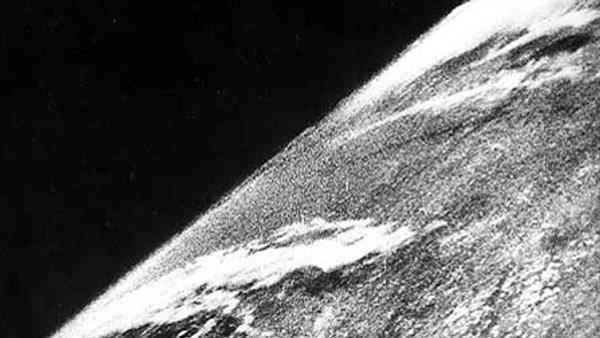
October 10, 1946: A US-launched V-2 rocket takes the first pictures of earth from space (62 miles, 100 km).
1946 Science Speculation Strip: A Round Trip To Mars.
October 22, 1946: 234 of the very best of the German engineers recruited by the Soviets are Shanghaied in a 4 AM sting operation by Soviet agents. The following morning the hung-over scientists and their families are loaded up, shipped to the USSR, and individually distributed to a number of research facilities engaged in rocket development throughout Stalin's realm. (Menaul)
November 1946: Former general director of the Mittelwerk factory, Georg Rickhey, is indicted for war crimes, and returned to Germany. He will be a defendant at the Dora Trial in Dachau, which will eventually begin on August 7, 1947. Although he will ultimately be acquitted, he will not be allowed to return to the US.

November 7, 1946: The 34-year old Wernher von Braun announces his engagement to Maria Louise von Quistorp, his 18-year old first cousin, who is still in Germany. He will later reveal that, at the age of 17, he had held his infant cousin in his arms, at her Baptism in the Lutheran Church: "That was the moment when I looked into her eyes and decided to marry her." He requests that the Army transport her, as well as his parents, to Fort Bliss where he would like the marriage to take place. See: February 14, 1947. (Piszkiewicz)
November 13, 1946: The presence of the German scientists at Fort Bliss had been an open secret that became even more open due to the May 29, 1946 crash landing in Mexico. On this day, a media blitz begins when a story appears in the El Paso Herald Post: "German Scientists to Be Interviewed. German scientists of whom Fort Bliss officials speak in whispers will answer questions for reporters soon." Von Braun and his team, who had been used to being 'state secrets' for most of their careers, now find themselves in a new and unfamiliar role in the media spotlight. It soon becomes apparent that von Braun thoroughly enjoys the attention, utilizing the free publicity to promote himself--and space exploration in general--in masterly style. (Piszkiewicz)
December 5, 1946: The El Paso Herald Post publishes the story: German Scientists Tell How V-2 Rocket Was Developed from Experimental Mile High Missile. In this front-page story, von Braun relates how the V-2 was developed, as well as the story of his surrender to the US Army. However, he has very little to say about the wartime use of the V-2. (Piszkiewicz)
December 6, 1946: The El Paso Herald Post prints three follow-up stories. The first is: V-2 Tests 33% Successful. In the body of the article this headline is contradicted, stating that 33% of the test firings were unsuccessful. Presumably, the remaining 67% were successful.
The second story in this days issue is: V-2 Rocket Sets New Speed Record. The short item announces that, not only has a previous firing of a V-2 reached a record-breaking speed of 3,4000 MPH, but that a rocket launch set for December 17, 1946 will release "man-made meteorites," fireworks for the enjoyment of the people of Texas and New Mexico.
The third story: German Scientists Have Own Court to Handle Breaches of Contract. Since the German scientists are technically illegal aliens, having neither passports or visas, the story details how they had set up what they called a "people's court" to internally police their own personnel. Von Braun had appointed Dieter Huzel as Judge and named several others permanent 'jurors.'
The results of one of these "people's court" cases will later be found in von Braun's FBI file:
Major James Hamill advised that in June, 1946 Magnus von Braun, the brother of Wernher, sold a bar of platinum to a jeweler in El Paso, Texas for $100,000. Magnus von Braun told the jeweler at the time of the sale that the platinum had been brought from Holland to the United States by his father, who had served in Europe during World War I. [The elder von Braun did not enter the United States until late March 1947, nine months after this incident.] The identity of von Braun was determined through his name and phone number which he had furnished to the jeweler. He was questioned by Major Hamill concerning this incident and readily admitted that he had brought the bar to the United States in violation of the Customs laws. Major Hamill stated that when the matter was brought to the attention of Wernher von Braun, as the director of the work by the German scientists, he had administered a severe physical beating to his brother. (Piszkiewicz)
December 9, 1946: TIME Magazine publishes the first national story on von Braun's Fort Bliss team: We Want with the West [sic]. The article's closing paragraph:
Seventy-five percent of the Germans' families live in a group of apartment houses at Landshut, Bavaria, where they are fed twice as well as the Germans outside. Chief complaint of the German scientists is the slowness of their mail (six weeks from Germany) and the absence of their families. As soon as possible, the Army promises, families will be brought over. The first batch sailed last week. The Germans see a new hope in that fact. Some day, they have been told, they may have a chance to become U.S. citizens. The fact that the U.S. is bringing their families to them seems to be a kind of guarantee that that is a promise.
December 14, 1946: Resolution of the UN General Assembly:
As an essential step towards the urgent objective of prohibiting and eliminating from national armaments atomic and all other major weapons adaptable now and in the future to mass destruction, and the early establishment of international control of atomic energy and other modern scientific discoveries and technical developments to ensure their use only for peaceful purposes...
December 30, 1946: US President Harry Truman receives a letter signed by Albert Einstein, union organizer Philip Murray, and religious leaders Norman Vincent Peale and Rabbi Stephan Wise, among others. The letter protests the Operation Paperclip German scientists being in the US:
We hold these individuals to be potentially dangerous carriers of racial and religious hatred. Their former eminence as Nazi party members and supporters raises the issue of their fitness to become American citizens and [to] hold key positions in American industrial, scientific, and educational institutions.
1947: The NII-88 group under Korolyov begins working on more advanced missile designs, with improvements in range and throw weight. The R-2 doubles the range of the V-2, and is the first design to utilize a separate warhead. This will be followed by the R-3, which will have a range of 3,000 kilometers, and thus can target bases in England. However, Glushko can't get the engines to develop the required thrust, and the project will be canceled in 1952. (Harford)

January 16, 1947: Because of the Top Secret nature of his work, Wernher von Braun had been kept in obscurity in Nazi Germany. On this day, he speaks in public for the first time in fifteen years, in an address to the El Paso Rotary Club. Since he is restricted from revealing anything about his present work for the Army, he speaks on the topic: Future Developments of the Rocket. Von Braun recommends that the following equipment be developed and built:
1. An enlarged V-2 as a "space ship."
2. A three-stage rocket able to lift an artificial satellite into orbit.
3. A winged rocket that could re-enter the atmosphere and land safely.
4. A space station shaped like a wheel to produce artificial gravity as it rotated. This space station would be used as a base for trips to the Moon and planets. (Piszkiewicz)
1946 Science Speculation Strip: First Rocket To The Moon.
February 14, 1947: After the US Army refuses to transport Wernher von Braun's fiancée from Germany so that the two can marry, von Braun departs for occupied Germany. (Piszkiewicz)

February 20, 1947: Fruit flies become the first living things in space as a V-2 rocket containing a jar of them (I wonder if there were air-holes punched in the bottle cap?), is launched from the White Sands Proving Ground, reaching an altitude of 60 miles. (Burrows)
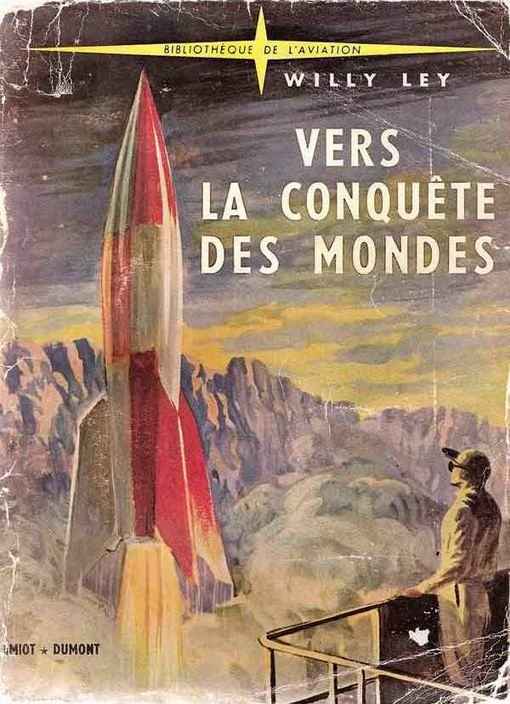
1947 Science Fact Article: Can V-2 Be Improved by David A. Anderton.
February 1947: The Soviets complete the transfer of all rocket technology from East Germany into secret locations in the USSR. (Menaul)March 1, 1947: Wernher von Braun weds his first cousin, Maria Louise von Quistorp, at the Lutheran Church in Landshut, Bavaria. (Piszkiewicz)
March 3, 1947: A story announcing von Braun's marriage appears in the El Paso Herald Post: Story of Wernher von Braun's marriage, encompassing his experience in rocket development in Germany and his family background. (Piszkiewicz)
March 1947: The wives and families of the Fort Bliss rocket scientists begin arriving from Germany. (Piszkiewicz)
1947 Science Fact Article: Push For Pushbutton Warfare by Willy Ley.

March 1947 Science Fact Article: How You'll Fly to the Moon.
March 24, 1947: W. A. Higenbotham, the executive secretary of the Federation of American Scientists, writes a letter to President Truman demanding that the German scientists of Operation Paperclip be denied jobs in private industry or higher education:
Any favor extended to such individuals, even for military reasons represents an affront to the people of all countries who so recently fought beside us, to the refugees whose lives were shattered by Nazism, to our unfortunate scientific colleagues of former occupied lands, and to all those others who suffered under the yoke these men helped to forge . . . . [The] wholesale importation of scientists is not in keeping with the best objectives of America and foreign policy.
March 26, 1947: Von Braun returns to Fort Bliss with his parents and his new wife. Since his brother Magnus is already at Fort Bliss, the von Brauns are almost all now reunited as immigrants in America. Only his brother Sigismund, a former diplomatic officer to the Vatican, remains in Germany, employed as a translator for the International Military Tribunal at Nuremberg. (Piszkiewicz)

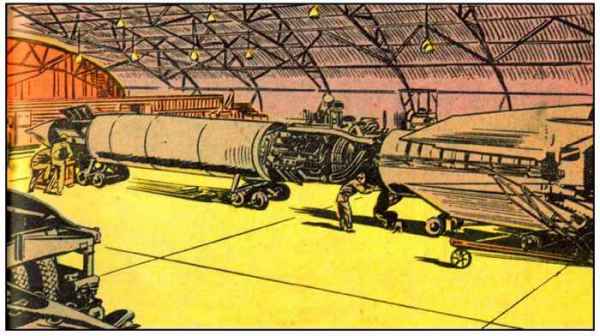
April 19, 1957: Sergey Korolyov, who had joined the Soviet Communist Party in 1952, is finally fully 'rehabilitated,' and the Soviet Government acknowledges that his sentence had been unjust. (Harford)
June 18, 1947: Von Braun signs an affidavit detailing his relationship and membership in the Nazi SS:
While a student at the Institute of Technology in Berlin, I joined the DVL (Deutscher Luftsport-Verband--German Sport Aviation Club) in order to become admitted to the aviation school at Berlin-Staaken. There I [received] my pilot's license in summer 1933 . . . . In summer 1934, the club was absorbed by the N. S. Fliegerkorps (National Socialist Aviation Corps). All members of their DVL were taken over automatically by the latter. I remained a member of the Fliegerkorps until approximately summer 1935. [Von Braun continued flying when he entered military service with the Luftwaffe the following year.]
In fall 1933, I joined the SS horseback riding school on the "Reitersturm I" at Berlin-Halensee. I was there twice a week and took riding lessons. The entire outfit [never participated] in any activity whatever outside the riding school during my connection with it. In the summer 1934, I got my discharge from the Reitersturm.
In 1939 [his record, however, indicates the year was 1937], I was officially demanded [sic] to join the National Socialist Party. At this time I was already Technical Director of the Army Rocket Center at Peenemuende . . . . My refusal to join the party would have meant that I would have to abandon the work of my life. Therefore, I decided to join. My membership in the party did not involve any political activity.
In spring 1940, one SS-Standartenfuehrer (SS Colonel) Mueller … looked me up in my office at Peenemuende, and told me that Reichsfuehrer SS Himmler had sent him ,with the order to urge me to join the SS. I called immediately on my military superior for many years in the Kriegsministerium (War Department), Major General Dr. Dornberger. He informed me that … if I wanted to continue our mutual work, I had no alternative but to join.
After having received two letters of exhortation from Mueller, I finally wrote him my consent. Two weeks later, I received a letter reading that Reichsfuehrer SS Himmler had approved my request for joining the SS and had appointed me Untersturmfuehrer (lieutenant).
From then on I received a written promotion every year. At the war's end I had the rank of Sturmbannfuehrer (Major). But nobody ever requested me to report to anyone or to do anything within the SS.
In addition to the SS I was a member of the following organizations: DAF (Deutsche Arbeitsfront, Trade Union); NSZ (Nat. Soc. Welfare Organization); Deutsche Jagerschaft (Hunting Org); Reichsluftschutzbund (Air Raid Protection Organization).
July 1, 1947: Congressman John D. Dingell, Democrat from Detroit, Michigan, denounces Operation Paperclip on the floor of the House of Representatives:
I have never thought that we were so poor mentally in this country, that we have to go and import those Nazi killers to help us prepare for the defense of our country. A German is a Nazi, and a Nazi is a German. The terms are synonymous.
July 1, 1947: A story appears in the El Paso Times: German Scientists in El Paso Blasted. The story relates the growing opposition to the presence of the Operation Paperclip scientists--without naming any names--in the US. Stating the Army's position, the article noted that the Nazi scientists had now been employed by the Army for over a year and had proved to be "technically and morally to the satisfaction of the War Department" and thus "wider avenues of research have been opened to them." However, the article continues:
The British [press] warned that some of the scientists had perfected rockets which had killed British women and children, and that some had committed war crimes more serious than those for which other Nazis had to hang. For months, the New York Times, in articles, had been warning Americans that, among the scientists at El Paso, were some very active Nazi party members.
July 27, 1947: A story appears in the El Paso Times: Scientists Not Seeking Citizenship. In response to public criticisms that the German rocket scientists were applying for citizenships, a State Department spokesman announces that none had actually applied for citizenship, and that none of them would even be eligible to do so for two more years. See: November 5, 1947. (Piszkiewicz)
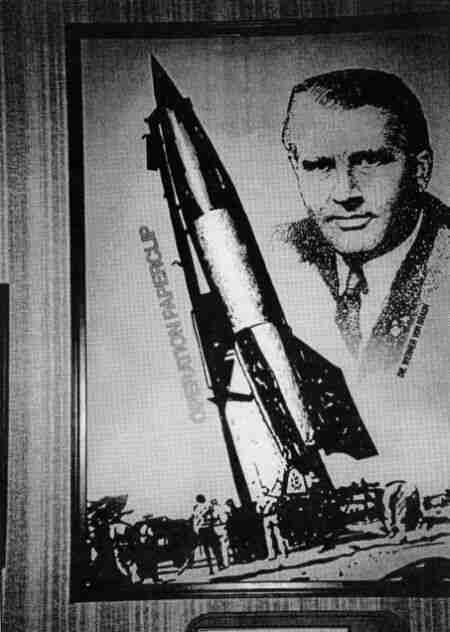
August 7 - December 30, 1947: Trial begins at the Dachau internment camp against those involved in the operation of Camp Dora. Of twenty-four indicted defendants, fifteen Camp Dora Kapos and SS guards will eventually be convicted. Only one will be executed. (Kapos were concentration camp inmates, usually common criminals, who had been recruited by the SS to do the dirty work of keeping the slave laborers in line.)
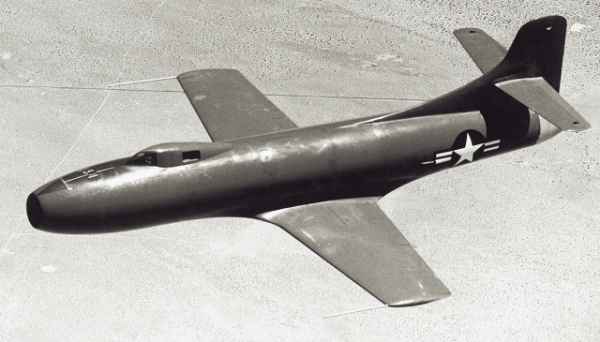
August 20, 1947: The American Douglas Skystreak single-engine turbojet-powered research aircraft piloted by Commander Turner Caldwell, USN, sets a new world speed record (See: October 2, 1941) of 641 miles per hour (1,032 km/h). The Skystreaks are powered by one General Electric engine and carry 230 gallons of aviation fuel (kerosene).
September 13, 1947: FBI Director J. Edgar Hoover writes a letter to the director of intelligence for the US Army, Lt. General Stephen J. Chamberlain, advising him that no classified technical information should be provided to the German scientists of Operation Paperclip. Chamberlain replies by pointing out that this is an absurd recommendation as it is the Germans themselves who have been developing the information. He informs Hoover, a fanatical anti-Communist, that the Germans are staunch allies in the battle against the Reds, and asks the Director to provide visas to the scientists. Hoover agrees, thus allowing the Germans to become legal residents in the US. (Piszkiewicz)
September 18, 1947: From a report for inclusion in von Braun's dossier, from the Military Governor: Office of Military Government for the US (OMGUS):
Based on available records, subject [von Braun] is not a war criminal. He was an SS officer but no information is available to indicate that he was an ardent Nazi. Subject is regarded as a potential security threat by the Military Governor, Office of Military Government for the US. A complete background investigation could not be obtained because subject was evacuated from the Russian zone of Germany.

1947: Rabbi Stephan Wise pens a letter to the US Secretary of State, protesting the "ardent pro-Nazis" of Operation Paperclip being in the US while visas to concentration camp survivors are being delayed:
Red tape, lack of shipping facilities, and every possible handicap face these oppressed people, while their oppressors are brought to this country and are favorably housed and supported at our expense. As long as we reward former servants of Hitler while leaving his victims in D.P. (Displaced Persons) camps, we cannot pretend that we are making real effort to achieve the aims we fought for.
October 14, 1947: Defense counsel for Georg Rickhey, on trial in Germany, requests that von Braun be made available to testify on Rickhey's behalf. The Army Ordnance staff refuses to allow it. However, since the serious nature of the charges against the defendant could result in a penalty of death, von Braun is allowed to swear a deposition. The questions posed by Rickhey's counsel are very narrow in scope, and von Braun is not asked anything that would tend to incriminate him. It should be noted, however, that while von Braun consistently professed to be uninvolved in the activities of the Mittelwerk, his answers reveal extensive knowledge of its operations
. . . .
12. Q: During your visit did you observe general working conditions in the Mittelwerk factory from May 1944 to April 1945?
A: Working conditions at the Mittelwerk were continuously improved during the entire period from the last months of 1943 up to my last visit to the plant. In the beginning, such condition were extremely primitive, since the tunnels … were not fit in any way for starting accurate production and to absorb many thousands of workers. Since a camp was not available, the prisoners were housed in the tunnels proper under the most primitive conditions. However, in the summer of 1944 considerable improvements had been made or were partly under construction...
November 5, 1947: A story appears in the El Paso Times: German V-2 Scientists Here among 72 Asking Citizenship. The story details an announcement by Major Hamill, who states that every German at Fort Bliss eligible to do so has applied for American citizenship, and every one not yet eligible nevertheless plans to renounce their German citizenship.
December 4, 1947: The US Joint Intelligence Objectives Agency (JIOA) requests that the director of Intelligence of the European Command assist in clearing the German scientists of the damaging assessments that they are security risks. From a memorandum signed by JIOA director Bosquet Wev:
1. OMGUS security reports recently forwarded from your headquarters classify (14) specialists [including Wernher von Braun] as potential or actual threats to the security of the United States . . . .
3. There is very little possibility that the State and Justice Departments will agree to immigrate any specialist who has been classified as a potential or actual security threat to the United States. This may result in the return to Germany of specialists whose skill and knowledge should be denied other nations in the interest of national security.
4. It is requested that the specialists ... be reviewed and that new security reports be submitted where such action is deemed appropriate in view of the information submitted in this letter.
February 26, 1948: OMGUS, acquiescing to the December 4, 1947 request of JIOA for updated security evaluations of von Braun and his team, submits a revised evaluation designed to allow the scientists to remain in the US:
Further investigation of Subject [von Braun] is not feasible, due to the fact that his former place of residence is in the Russian Zone, where US investigations are not possible. No derogatory information is available on the subject individual, except NSDAP records, which indicate that he was a member of the Party from 1 May 1037 and was also a Major in the SS, which appears to have been an honorary commission. The extent of his Party participation cannot be determined in this Theater. Like the majority of members, he may have been a pure opportunist. Subject has been in the United States more than two years and if, within this period, his conduct has been exemplary, and he has committed no acts adverse to the interests of the United States, it is the opinion of the Military Governor, OMGUS, that he may not constitute a security threat to the United States.
May 13, 1948 - July 29, 1950: The US Army launches the first of eight two-stage missiles--a V-2 first stage and a Wac Corporal second stage with an instrument package--under Project Bumper. The first six are launched from White Sands, while the last two take off from the Long-Range Proving Ground at Cape Canaveral, Florida. Project Bumper will squeeze all possible potential out of existing rocket technology. Any further advances will require a new generation of rockets. (Piszkiewicz)
May 22, 1948: The Soviets, after a year or so of steady transfers, succeeds in collecting most of their captured German rocket specialists on the island of Gorodomlya, previously utilized as a biological warfare facility in the 1930's. The 234 scientists are given the task of designing a 600 km range rocket to be known as the G-1/R-10. (Menaul)
1948: The underground slave-labor V-2 production facility at Nordhausen is blown up by Soviet demolition specialists.
August 16, 1948: The FBI opens a file on von Braun for the purpose of evaluating "the internal security aspects of the immigration of von Braun into the United States for permanent residence." They begin the investigation by examining the JIOA files that were recently purged (February 26, 1948) of any suggestion that von Braun is a security risk. While the file still contains some negative comments on von Braun's character, the FBU will ultimately conclude that he should be allowed to legally immigrate to the US.
September 15, 1948: Army Ordnance submits a proposal to the Department of Defense's Committee on Guided Missiles for a feasibility study on satellites based on von Braun's work.
December 9, 1948: Maria von Braun gives birth to the couple's first child, Iris Careen. (Braun)
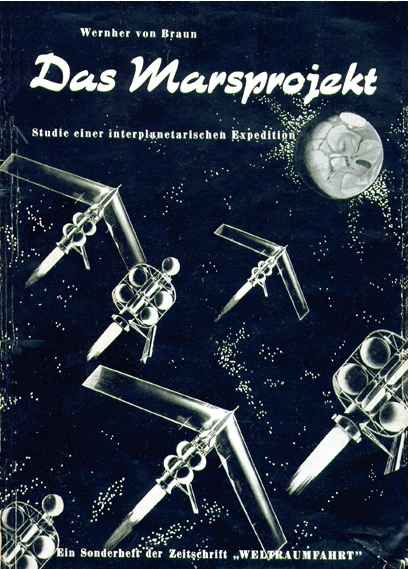
1948: Von Braun completes the manuscript for a work of non-fiction, The Mars Project (Das Marsprojekt), a technical specification for a manned expedition to Mars. It is the first "technically comprehensive design" for such an expedition, and has been regarded as "the most influential book on planning human missions to Mars." However, it will be rejected by well over a dozen publishers before finally seeing print in 1953. From the introduction:
The study will deal with a flotilla of ten space vessels manned by not less than 70 men. Each ship of the flotilla will be assembled in a two-hour orbital path around the earth, to which three-stage ferry rockets will deliver all the necessary components such as propellants, structures, and personnel. Once the vessels are assembled, fueled, and "in all respects ready for space," they will leave this "orbit of departure" and begin a voyage which will take them out of earth's field of gravity and set them into an elliptical orbit around the sun.
At the maximum solar distance of this ellipse which is tangent to the Martian orbit, the ten vessels will be attracted by the gravitational field of Mars, and their rocket motors will decelerate them and swing them into a lunar orbit around Mars.

August 14, 1949: Major General Holger Toftoy, head of the Army's rocket development program, begins negotiations to purchase the Redstone Arsenal in Huntsville, Alabama, in order to develop it into a rocket development facility. His efforts will ultimately be successful, and by November of 1950 all of the 130 German scientists on von Braun's team will join 500 military personnel, 120 civilian government workers and several hundred employees of GE at Redstone. Von Braun will become the Technical Director, Guided Missile Development Group, which is basically the same position he held at Peenemuende. (Piszkiewicz)
September 23, 1949: Statement by President Truman:
...I believe the American people to the fullest extent consistent with the national security are entitled to be informed of all developments in the field of atomic energy. That is my reason for making public the following information. We have evidence that within recent weeks an atomic explosion occurred in the USSR. Ever since atomic energy was first released by man, the eventual development of this new force by other nations was to be expected...
November 2, 1949: In the company of an Army escort, von Braun crosses the border into Mexico and travels to the US consulate in Ciudad Juarez. Obtaining a visa to enter the US, he returns a few hours later as a legal immigrant. By the spring of 1950, most of the German rocket team will make the same trip for the same purpose. (Piszkiewicz)

May 14, 1950: The Sunday Huntsville Times runs a feature story: Dr. von Braun Says Rocket Flights Possible to Moon.
June 25, 1950: Ratcheting up the Cold War another notch, North Korea, with the backing of the USSR and the People's Republic of China, invades South Korea. This will provide an opportunity for the von Braun Team when the Army orders a feasibility study for a surface-to-surface ballistic missile with a range of 500 miles. See: July 10, 1951. (Piszkiewicz)
June 27, 1950: Destination Moon, the first major science-fiction film produced in the United States that dealt seriously with the prospect, problems and technology of space travel, is released. The eminent science-fiction writer, Robert A. Heinlein, contributed significantly to the script and served as a technical adviser. Seven years before Sputnik, 19 years before the actual moon landing, the movie clearly spells out a rationale for the space race: unnamed enemies--clearly understood at the time to be the Soviets--are sabotaging the American space program; and unless the West beats them to the moon, they will establish a strategic advantage to conquer the world.
1950: Lieutenant Colonel James P. Hamill gives von Braun an important assignment. Robert H. Goddard's estate, with backing from the Guggenheim Foundation, has filed suit against the US government claiming that the V-2 rockets being tested at White Sands, and newer rockets being developed, are infringing upon many of Goddard's patents. Von Braun is asked to read through the over 200 patents in Goddard's name and write a report from an engineering standpoint. While von Braun had never seen any of Goddard's patents before, he discovers that many devices and features he had developed independently are, nonetheless, infringements on many of the famed rocket pioneers patents. In his report, he identifies the use of jet vanes for flight path control, turbo-pumps to feed liquid fuels to the engines, gyroscopic guidance controls, and much more, as possible infringements. He concludes that Goddard had a brilliant and inventive mind, and he becomes an admirer, and life-long defender, of the late rocketeer. (Piszkiewicz)
Wernher von Braun: [Goddard was] ahead of us all [and] in the light of what has happened since his untimely death, we can only wonder what might have been if America realized earlier the implications of his work. I have not the slightest doubt that the United States today would enjoy unchallenged leadership in space exploration had adequate recognition been accorded to him.

1950 Science Fact Article: Our Turbulant Atmosphere, Part One, Part Two, by Willy Ley.
October 1950: From an interview of Wernher von Braun:
In 1932, the idea of war seemed to us an absurdity. The Nazis weren't even in power. We felt no moral scruples about the possible future abuse of our brain child. We were interested solely in exploring outer space. It was simply a question with us of how the golden cow would be milked most successfully.
April 3, 1951: Now that the Soviet rocket program is well underway, the shanghaied German scientists begin to be repatriated.
June 14, 1951: From the FBI Files of Wernher Von Braun:
The interview with the subject should be conducted by an experienced agent in a discreet and tactful manner . . . . In reporting the information received during this interview, the interviewing agent should include his comments and evaluation concerning the attitude, cooperation, and sincerity of subject ... as to his intention of obtaining United States Citizenship. (HAL)
June 30, 1951: A total of 67 V-2's have by now been tested at White Sands.
July 10, 1951: After a feasibility study by von Braun's team over the space of one year (see June 25, 1950), Army Ordinance formally assigns responsibility for designing a new ballistic missile to the Redstone Arsenal. Ordinance accepts a reduced range of 200 miles, but increases the payload requirement to three tons so that the missile can accommodate an atomic warhead. While a 200-mile range is only slightly greater than that of a V-2, the addition of an atomic warhead increases its potential impact by many orders of magnitude. (Piszkiewicz)
July, 19, 1951: From the FBI Files of Wernher Von Braun:
... von Braun and his wife have applied for their first citizenship papers and he stated they were looking forward to becoming American citizens. As previously stated, he has purchased a home in Huntsville, and mentioned that his plans at the present time are to reside in Huntsville, Alabama. (HAL)

October 12, 1951: The first serious planning for the exploration of space takes place at the Hayden Planetarium in New York City. Writer Willy Ley (above), who had left Germany before the war and never returned, coordinates this Space Travel Symposium. While he and von Braun had both been members of some of the same groups of rocket enthusiasts in Germany, the two had never been friends. Among the guests at the Symposium are Arthur C. Clarke, R. P. Haviland, Oscar Schacter, Heinz Haber, and two writers from Collier's Weekly Magazine. Von Braun does not attend. See: November 6-9, 1951. (Piszkiewicz)
November 6-9, 1951: Von Braun is invited to attend his first Space Travel Symposium, although he is not slated to speak. It is a space medical conference jointly sponsored by the Lovelace Foundation for Medical Education and Research, and the US Air Force School of Aviation Medicine; and is held in San Antonio, Texas. He meets an editor for Collier's Weekly Magazine, Cornelius Ryan, who had been to the previous symposium, and will later write an account of the Normandy Invasion; The Longest Day. Realizing that Collier's Weekly Magazine could be a great place to propagate the exploration of space to a wide audience, von Braun, along with Fred Whipple of Harvard, and Joseph Kaplan of UCLA, eventually convince a still-skeptical Ryan to publish a series of von Braun authored articles. (Piszkiewicz)
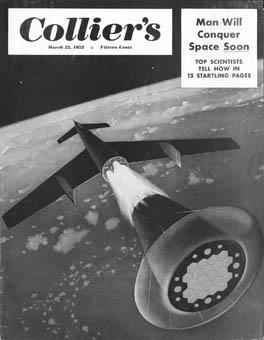

March 22, 1952: Collier's Weekly Magazine publishes Man Will Conquer Space Soon: Top Scientists Tell How in 15 Startling Pages, the first of a series of articles on manned space exploration by von Braun and a team of experts, with edits by Willy Ley. From the Introduction:
On the following pages, Collier's presents what may be one of the most important scientific symposia ever published by a national magazine. It is the story of the inevitability of man's conquest of space. What you will read here is not science fiction. It is serious fact. Moreover it is an urgent warning that the US must immediately embark on a long-range development program to secure for the West "space superiority." If we do not, somebody else will. That somebody else very probably will be the Soviet Union.
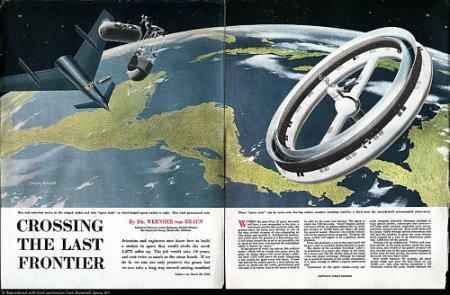
Von Braun, whose article Crossing the Last Frontier is the centerpiece of several articles in the issue, writes:
Within the next 10 or 15 years, the earth will have a new companion in the skies, a man-made satellite that could be either the greatest force for peace ever devised, or one of the most terrible weapons of war--depending on who makes and controls it . . . .
Small, winged, rocket missiles with atomic warheads could be launched from the station in such a manner that they would strike their targets at supersonic speeds. By simultaneous radar tracking of both missile and target, these atomic rockets could be accurately guided to any spot on earth. In view of the station's ability to pass over all inhabited regions of earth, such atom-bombing techniques would offer the satellite's builders the most important tactical and strategic advance in military history.
This issue of Collier's also features a question and answer section with von Braun supplying the closing answer:
Q: Would Soviet Russia enjoy any advantages in a race for space superiority?
Von Braun: Just one advantage of any importance so far as is known. Because the country is huge, and barricaded behind the Iron Curtain, the initial phases of a space program could be kept secret much more easily in the Soviet Union, than in the Western World . . . . The advantage in competition to conquer space probably rests with us--if we move quickly.
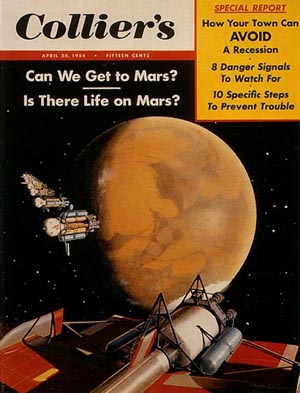
1952 Science Fact Article: Life in the Sky Big Eye for the Generals.
April 8, 1952: After considering and rejecting a series of names for their new ballistic missile, including "Ursa" and "Major," the von Braun Team officially settles on "Redstone." (Piszkiewicz)
May 8, 1952: Maria von Braun gives birth to a second daughter, Margrit Cecile. Von Braun is now making enough from the government to afford a nice, middle-class lifestyle; and purchases, on a FHA loan, a Huntsville home in the wooded hills north of the Tennessee River. The von Brauns join civic organizations, acquire library cards, and become members of the local Episcopal Church. He is also receiving recognition professionally, and is honored with memberships in the British Interplanetary Society, the American Rocket Society, and the Explorers' Club of New York. Life is definitely looking up for the von Brauns. (Piszkiewicz)

August 20, 1952: The first Redstone ballistic missile is successfully tested at Cape Canaveral. It is often described as a second generation V-2, incorporating many innovative features, including all-aluminum construction, and a completely internal guidance system. A 600-man Field Artillery Missile Group is required, in order to operate it. (Piszkiewicz)
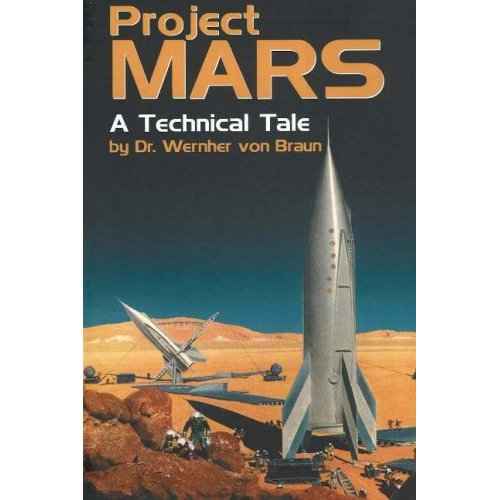
1952: Von Braun publishes the English version of his 1948 book Das Marsprojekt, The Mars Project, his plan for a manned Mars mission which will use his proposed space station as a staging point. This ambitious plan calls for a fleet of ten spacecraft each carrying in addition to cargo one 200-ton winged lander, with nine crew vehicles transporting a total of 70 astronauts.
November 20, 1952: From the FBI Files of Wernher Von Braun:
... von Braun also stated he had never received the Daily Worker Communist newspaper, never read a copy of the newspaper, and had never received any literature which he felt was Communistic in any way. (HAL)
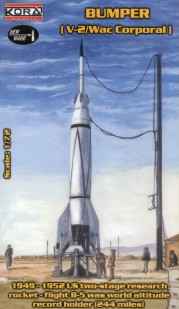
1952: 64 V-2s have been launched at White Sands by this time. One V-2 is used as the first stage of a two-stage missile named Bumper. The top half is a US WAC Corporal rocket.
March 1953: In an article entitled Space Superiority, published in the March-April issue of Ordnance, von Braun writes:
The atom bomb may have been the "ultimate weapon" heretofore, but this will not be the case much longer.
It is now the time … when we must relegate strategic bombing to a secondary position and seek a new "ultimate weapon" which [will] preferably not only return to us that deciding "edge" we once had over Red aggression, but likewise [be] kinder to the taxpayer.
We need fear no fundamental, immovable roadblocks along the path of further development of the large liquid [-fueled] rocket, as the principle difficulties have already been conquered. At some distance along this path--a very attainable distance, by the way--stands the multistage, orbital rocket ship bearing a crew out beyond the stratosphere.
The first nation to launch such a rocket will possess, in my opinion, what may well be the long-sought "ultimate weapon."
[A space station is also recommended.] The first and obvious military application of such a station is that of reconnaissance and observation.
The station would also operate improved radarscope equipment far superior to the present aircraft-borne devices and thus able to penetrate reliably the thickest cloud overcast.
An orbital reconnaissance station can pull up an iron curtain! . . . .
When it comes down to cases, the outstation is also a launching platform for orbital missions, against which there cannot be countermeasures. If we fire an atom-tipped, winged rocket backward from the station, so that its thrust diminishes its orbital velocity (relative to the station) by 1,070 miles per hour, it will succumb to gravity, and approach the earth on an elliptical path.
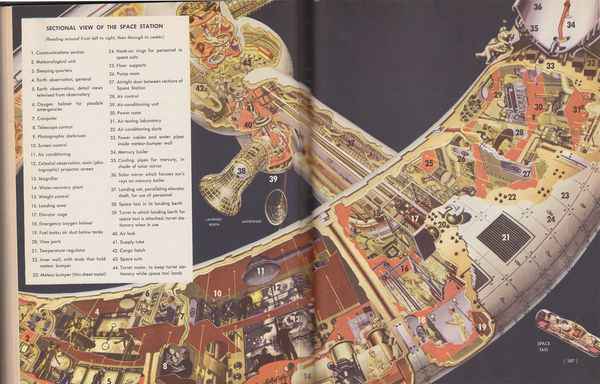
1953 Science Fact Article: Birth of the Space Station by Willy Ley.
November 22, 1953: The last member of the group of shanghaied scientists is repatriated to Germany.

1953 Science Fact Article: Those Clumsy Steps by Willy Ley.
June 25, 1954: A meeting attended by von Braun is held in Washington DC, to discuss the idea of launching an artificial satellite. It is proposed that off-the-shelf technology be used, to launch a 15 to 20 pound satellite on the tip of a Redstone. A joint Army-Navy working group is formed to plan what is known as Project Orbiter.
August 3, 1954: Navy representatives travel to Huntsville to confer with the Army on Project Orbiter.
September 15, 1954: Von Braun writes a secret report for Project Orbiter, entitled A Minimum Satellite Vehicle Based on Components Available from Developments of the Army Ordnance Corps. The report reveals that, von Braun is becoming expert at utilizing both technical and political arguments, and estimates a total cost of $100,000. An excerpt:
The establishment of a man-made satellite, no matter how humble, would be a scientific achievement of tremendous impact. Since it is a project that could be realized within a few years with [the] rockets and guided missile experience available now, it is only logical to assume that other countries could do the same. It would be a blow to the US prestige if we did not do it first.
1954 Science Fact Article: There's A Missile...Aimed At You!
October 15, 1954: Von Braun applies for a renewal of his "Secret" security clearance, which involves his having to take a lie-detector test. See December 3, 1954. (Piszkiewicz)
December 3, 1954: The results of von Braun's lie-detector test reveal that it had measured no reactions indicative of deception, while noting that the incarceration of his father-in-law, Alexander von Quistorp, "still in prison camp in the hands of the Communists," could possibly leave the rocket scientist susceptible to blackmail. (Piszkiewicz)
January 20, 1955: In order to improve the chances of approval for Project Orbiter, the Army and Navy invite the Air Force to join the project, and present a formal proposal to the assistant secretary of defense for Research and Development.

February 12, 1955: The Soviet government establishes the Baikonur Cosmodrome--the Soviet version of Cape Canaveral--in the Kyzylorda Province of Kazakhstan.
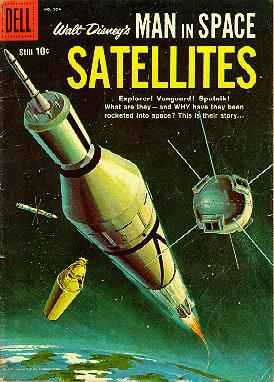
March 9, 1955: The TV show Man in Space, produced by Disney studios, is broadcast to an audience estimated to be between 42 to 100 million. Von Braun participates, not only as a technical director, but he appears on the show, establishing himself nationally as the foremost proponent of space travel. In precise English, he describes his plans for sending man into space:
If we were to start today on an organized, well supported space program. I believe a practical passenger rocket could be built and tested within ten years.
From Walt: Backstage Adventures with Walt Disney by Charles Shows, a Disney writer who worked with von Braun on Man in Space: On several occasions he worked non-stop for 12 hours at the studio, then took a taxi from Hollywood to Long Beach, about 50 miles away. There he rented a speedboat and piloted it 22 miles across the water to Catalina Island. Once there, von Braun skin-dived all night, then piloted his speedboat back to Long Beach at dawn. He rode a taxi to his hotel for a quick shower, then reported back to Disney for another long day's demanding work on space travel.
[One night, Shows gave von Braun a lift back to his hotel at the end of the day, asking him along the way if there is anything about America that he does not like.] "Yes," von Braun replies, "I don't like being treated like a foreign spy. Everywhere I go, the FBI has me followed. I can't even go to the bathroom without an FBI man tailing me . . . . Look behind us. That third car behind us has been tailing us since we left the studio. It's FBI men--they're always around. My telephone is bugged, and the FBI reads more of my mail than I do! I hope some day they'll trust me and leave me alone."
March 14, 1955: The United States National Committee for the IGY, a civilian organization, recommends that an artificial satellite be launched, to mark the forthcoming geophysical year.
April 15, 1955: Wernher von Braun, his wife and children, and 40 other German rocket scientists and their families--103 people in all--become American citizens, in a ceremony in the Huntsville High School auditorium. Von Braun:
This is the happiest and most significant day of my life. I must say we all became citizens in our hearts long ago. I have never regretted the decision to come to this country. As time goes by, I can see even more clearly that it was a moral decision we made that day at Peenemuende. (Piszkiewicz)
April 16, 1955: The Soviet Government announces that a permanent high-level, interdepartmental commission for interplanetary communications has been created in the Astronomic Council of the USSR Academy of Sciences. A group of Russia's top scientists is now officially working on a satellite program.
May 17, 1955: From an NCS (National Security Council) Memorandum: . . . .
2. I am impressed by the psychological [effect] of, as well as by the advantages of, having the first successful [satellite launch] result from the initiative of the United States, and by the costly consequences [that would ensue] of allowing the Russian initiative to outrun ours, through an achievement that will symbolize scientific and technological advancement to peoples everywhere. The stake of prestige that is involved makes this a race that we cannot afford to lose.
3. [Basically] new questions of ionosphere jurisdiction [are involved. And the] announced Soviet program in interplanetary communications makes it certain that a vigorous propaganda will be employed, to exploit all possible derogatory implications of any American success that may be [achieved. It is therefore] highly important that the U.S. effort be initiated, under auspices that are least vulnerable to effective criticism. The extraordinary opportunities for exploitation of superstitions on the one hand, and of imputed military hazards on the other, that are inherent in a scientific "breakthrough" of such novelty, make it imperative to enlist many voices, speaking for numbers of nations, to allay the potentially boundless fears that may be stirred up, even though they are quite unwarranted.
I agree, therefore, with the suggested procedure of having our Government announce that it is ready to support the project through the U.S. National Committee of the International Geophysical Year...
May 20, 1955: From an NCS (National Security Council) Memorandum:
Considerable prestige and psychological benefits will accrue to the nation [that is first] successful in launching a satellite. The inference of such a demonstration of advanced technology, and its unmistakable relationship to intercontinental ballistic missile technology, might have important repercussions on the political determination of free world countries to resist Communist threats, especially if the USSR were to be the first to establish a satellite. Furthermore, a small scientific satellite will provide a test of the principle of "Freedom of Space." The implications of this principle are being studied within the Executive Branch. However, preliminary studies indicate that there is no obstacle under international law to the launching of such a satellite...
May 26, 1955: From an NCS (National Security Council) Memorandum:
At the conclusion of Mr. Anderson's briefing, the President [Eisenhower] inquired whether any members of the Council wished to hear [any further details about] this project from Dr. Quarles, Assistant Secretary of Defense for Research and Development. At the invitation of the President, Dr. Quarles proceeded to describe the earth satellite in greater detail.
The Vice President [Nixon] inquired whether it would be possible, eventually, to develop an earth satellite [that] could stay up indefinitely. Dr. Quarles replied that it might be possible to do this at a later time.
Ambassador Lodge warned that the public relations aspects of establishing an earth satellite, as proposed in NSC 5520, should be very carefully worked out. Otherwise, the public relations effects could be harmful to the United States. Dr. Quarles replied that he thought that the [link to the International Geophysical Year,] which it was proposed that the U.S. use in launching the earth satellite, would be effective in meeting the problem cited by Ambassador Lodge...

July 17, 1955: Disneyland has its grand opening. Von Braun, in collaboration with Ward Kimball, is the main creative contributor to one of its main features, Tomorrowland. Its centerpiece is a 76-feet tall V-2 shaped rocket on three shock-absorbing legs. The white rocket with red trim is named TWA after Trans World Airways, which has purchased the naming rights. Behind the building is the Rocket to the Moon attraction, which provides visitors with a simulated journey of a journey to and around the Moon, but no actual landing. There is still much uncertainty as to whether or not a landing on the Moon is even possible, with much speculation that its surface may be covered with a thick layer of "Moon Dust" that would swallow any lunar-lander whole.
July 29, 1955: The Eisenhower Administration announces that it intends to launch an artificial satellite into orbit during the International Geophysical Year (IGY) which is set to begin in July 1957.
1955 Science Fact Article: The Day After We Land on Mars by Robert S. Richardson.
July 30, 1955: Sergey Korolyov's group has been following the Western press, and believes it is possible to beat the US to the punch. With Korolyov's urging, the USSR's Soviet Academy of Sciences announces on this day that it, too, intends to launch an artificial satellite. (Harford, Piszkiewicz)
September 9, 1955: The Department of Defense Advisory Group on Special Capabilities votes 7 to 2 to approve the US Air Forces Vanguard proposal for launching a satellite, instead of the Army-Navy Project Orbiter plan.
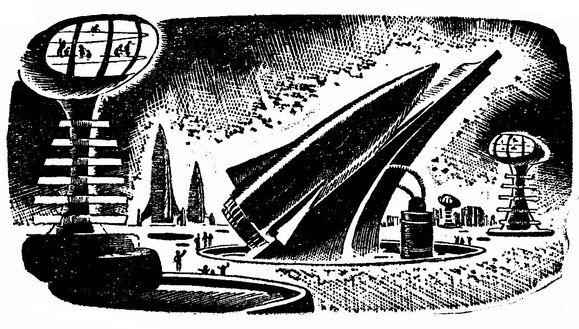
December 28, 1955: The second Disneyland program on space, Man and the Moon, is broadcast. Again, von Braun plays a big part in the production, explaining to the millions of viewers, not only his concept for a lunar spaceship, but a space station as well:
Our space station will have the shape of a wheel measuring 250 feet across. The outside rim will contain living and working quarters for a crew of 50 men. Just below the radio and radar antenna is an atomic reactor. Its heat will be used to drive a turbo generator which supplies the station with electricity.
February 1, 1956: As a sort of consolation prize for losing the Project Orbiter contract to the Air Force, von Braun's group at Redstone receives approval to develop an intermediate range (1,500 miles) ICBM, with a 2,500 pound payload dubbed Jupiter. The Redstone Arsenal is renamed the US Army Ballistic Missile Agency (ABMA). Brig. General John B. Medaris becomes commander, with von Braun as director of the Development Operations Division, under Brig. General Holger Toftoy.
February 29, 1956: The Department of Defense releases a sixty-one minute long educational film entitled The Challenge of Outer Space. The DOD's description of the film, featuring von Braun, explains that he will describe "the characteristics of present day guided missile models, how they function, the problems involved in achieving operational effectiveness, and the challenge presented by outer space in future development."
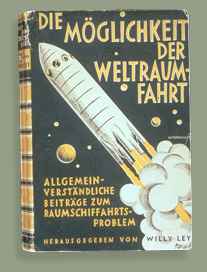
1956 Science Fact Article: Missing Ingrediant by Willy Ley.
April 18, 1956: Nikita Khrushchev accompanies Soviet leader Bulganin on a state visit to Great Britain. Khrushchev:
Macmillan, Lloyd, and some influential Conservative politicians joined us for supper. Eden's wife was the hostess...During dinner, Mrs. Eden asked us, "Tell me, what sort of missiles do you have? Will they fly a long way?" "Yes," I said, "they have a very long range. They could easily reach your island and quite a bit farther." She bite her tongue. It was a little bit rude of me to have answered her as I had. Perhaps she took it as some sort of threat. We certainly didn't mean to threaten anyone. We were simply trying to remind other countries that we were powerful and deserved respect, and that we wouldn't tolerate being talked to in the language of ultimatums. (Crankshaw II)
April 19, 1956: Nikita Khrushchev, in his memoirs, characterized remarks he made this day to a meeting with the Britain's First Lord of the Admiralty thus:
Gentlemen, here you are, the representatives of Great Britain, and the whole world knows there was a time when Britannia ruled the waves. But all that era is now past, and we must look at things realistically. Everything has changed. Your specialists have told me how much they admire the battle cruiser which brought us here. Well, I'll tell you something. We will be happy to sell you this cruiser if you really want it because it's obsolete. Its weapons have been outdated by new weapons. Besides, cruisers like ours no longer play a decisive role. Nor do bombers. Now it's submarines that rule the sea, and missiles that rule the air—missiles that can strike their targets from long distances. (Crankshaw II)
May 3, 1956: From an NCS (National Security Council) Memorandum:
The President [Eisenhower] said that he had not been notably enthusiastic about the earth satellite program when it had first been considered by the National Security Council, but that we certainly could not back out of it now. The President could not imagine the United States having made an announcement that it proposed to launch an earth satellite, and then failing to deliver on its commitment. To this, Secretary Humphrey replied by proposing that we spend the sum of $20 million originally estimated to be the cost of launching an earth satellite, and see whether we could get one up into its orbit for this amount of money.
Secretary Wilson said that the successful launching of an earth satellite might one day provide information of very considerable value to the defense of the United States. He was presently engaged in trying hard to prevent the Soviets from having access to valuable secrets of the Defense Department. Accordingly, he was much interested to know whether, if the earth satellite were successful, all the information we obtained from its flight was going to be made known to all the nations of the world, as seemed to be proposed by the people responsible for the International Geophysical Year programs. If this proved to be the case, Secretary Wilson asked how we were expected to keep ahead of the Soviets.
Mr. Anderson pointed out to the President that there were two parts to the problem before the National Security Council. One was the recommendation to go ahead with the development of the six-satellite program. The other was the question of the need for additional satellites. The answer to this would come later...
July 29, 1956: Presidential Press Secretary James C. Hagerty issues a statement from the White House:
On behalf of the President [Eisenhower], I am now announcing that the President has approved plans by this country for going ahead with the launching of small unmanned earth-circling satellites, as part of the United States participation in the International Geophysical Year, which takes place between July 1957 and December 1958. This program will, for the first time in history, enable scientists throughout the world to make sustained observations in the regions beyond the earth's atmosphere. The President expressed personal gratification that the American program will provide scientists of all nations, this important and unique opportunity for the advancement of science.
September 20, 1956: Von Braun's team launches the first Jupiter C from Cape Canaveral. Although the nose cone is never recovered, the missile reaches an altitude of 682 miles and a distance of 3,400 miles, a record that will stand for the next two years.
January 24, 1957: From an NCS (National Security Council) Memorandum:
Dr. Waterman pointed out that an earth satellite was unique as a means of observing space because, once it was in position, it observed without the need of any unit of propulsion. Accordingly, if successfully launched, the earth satellite would provide us with a continuous record of information on outer space. Such information would be of enormous value . . . .
In view of the above possibilities, Dr. Waterman believed that ordinary prudence suggested that we do all we possibly could to achieve this kind of information. Dr. Waterman also pointed out that the United States was now taking the lead--as compared to the Soviets--in the development of instrumentation for satellites. While he believed that the Russians might well surprise us in the achievement of a launching unit, he did not believe that they were likely to equal us in the instrumentation of the satellite itself, although they will do their utmost to try to get ahead of us in this area also.
The foregoing remarks, continued Dr. Waterman, explained the recommendations of the National Science Foundation for a program to include six extra satellites. Such a program of twelve launchings Dr. Waterman believed would guarantee at least one successful launching...

1957 Science Fact Article: Who'll Own the Planets by Willy Ley.
May 10, 1957: From an NCS (National Security Council) Memorandum:
After Mr. Cutler had finished his briefing, and had noted that the costs of the program had increased from the original estimate (May 1955) of $15-20 million to the estimate of April 1957--of $110 million--he turned to call upon Secretary Holaday to present the Defense Department report. The President [Eisenhower], however, interrupted with a vigorous complaint to Mr. Cutler that, before he slid over some very important facts, it would be well to recall that the original program, calling for six satellites, was primarily a safety program, designed to assure that at least one of these six satellites could be successfully orbited. There was no intention necessarily to launch six satellites. Another problem which disturbed the President was the very costly instrumentation currently being provided for the six satellites. Such costly instrumentation had not been envisaged, when NSC 5520 had originally been approved by the President. The President therefore stressed that the element of national prestige, so strongly emphasized in NSC 5520, depended on getting a satellite into its orbit, and not on the instrumentation of the scientific satellite...

May 15, 1957: The first testing of a new missile codenamed 8K71, soon renamed the R-7 Semyorka, takes place. Though based on German technology and built with the help of German scientists, the rocket boasts several important Soviet innovations. (Menaul)
From Dulles: A Biography of Eleanor, Allen, and John Foster Dulles and Their Family Network by Leonard Mosley: The U-2 (high-altitude spy-plane) had cost a fortune to develop, but its pioneer, Richard Bissell, saw well ahead of time that it would soon become outmoded and the next stage of extraterrestrial surveillance would have to be developed. He went to Allen (Dulles, the Director of Central Intelligence) and said: "I am very worried that the Russians are getting ahead of us in rocketry and space. In your capacity as head of psychological warfare, you ought to persuade the administration to do something about it. Because if, in two or three years, the Russians have a space rocket and we have nothing, that could have a shattering effect across the world."
This was several months before the Soviet Union put Sputnik into space in October 1957, and though there were rumors and hints from CIA sources that t was coming, no one had yet responded to it. Allen suggested that Bissell go over and talk to the air force, who sent him on to Charles Wilson, the Secretary of Defense. The feeling around was that such things as space programs were "the kind of foolishness Democrats indulge in, and we Republicans cut down on." So once more, Allen agreed to fund money for a space satellite out of CIA secret funds, and went to see the President about it.
In February 1958, he called in Richard Bissell to see him. Edwin Land was already there. Allen said that the President had approved the development and operation of a reconnaissance satellite, and that Bissell would be in charge for the Agency and would have an Air Force officer as his co-director...Bissell knew less about space rockets than he had about U-2's, and he and his aides learned the hard way.

August 21, 1957: The USSR launches the worlds first true ICBM (Intercontinental Ballistic Missile), the R-7 Semyorka. (Menaul)
Sergey Pavlovich Korolyov, as quoted in The Russian Space Bluff by Leonid Vladimirov: We [in the USSR] followed closely the reports of preparations going on in the United States of America to launch a sputnik called, significantly, Vanguard. It seemed to some people at the time that it would be the first satellite in space. So we then reckoned up what we were in a position to do, and we came to the conclusion that we could lift a good 100 kilograms (220 lbs.) into orbit. We then put the idea to the Central Committee of the Party, where the reaction was: "It's a very tempting idea. But we shall have to think it over." In the summer of 1957 I was summoned to the Central Committee offices. The OK had been given.

October 4, 1957: A modified version of the R-7 Semyorka launch vehicle propels Sputnik 1, the world's first artificial satellite, into orbit. The big ball weighs 183 pounds and circles the earth at an altitude of 560 miles and a speed of 18,000 MPH. The reaction of Senator Lyndon B. Johnson: "We have got to admit frankly that the Soviets have beaten us at our own game—daring, scientific advances in the atomic age." (Fleming)



October 5, 1957: From Spandau Diary by Albert Speer:
October 8, 1957: From an NCS (National Security Council) Memorandum:
Apparently, the thrust of the rocket used by the Russians to put up their Satellite was around 200,000. The thrust of our rockets runs from 27,000 (Navy), up to 150,000 at present. It is believed that the Russian rocket was the one used in their August rocket tests. Quarles pointed out that the Army had sent up a rocket within a year 6/700 miles in the air. Its speed was much lower than the speed of the rocket used by the Russians--probably mach 12 at the peak--with a very much lower speed at the top of the trajectory.
According to the newspapers, the Russians have offered to take up some of our instrumentation in the next Satellite launched. This will pose a very difficult problem for us, as we do not think they know how to make some of the very delicate material, which we will include in our Satellite. Apparently, our scientists believe the present Russian Satellite is far more crude, and less instrumented, than what we have in mind...
October 10, 1957: From an NCS (National Security Council) Memorandum:
Secretary Quarles thought it quite proper to emphasize the paramount scientific aspect of the U.S. earth satellite program. Our Government had never regarded this program as including as a major objective that the United States should launch an earth satellite first though, of course, we have always been aware of the cold war implications of the launching of the first earth satellite.
Another of our objectives in the earth satellite program was to establish the principle of the freedom of outer space, that is the international rather than the national character of outer space. In this respect the Soviets have now proved very helpful. Their earth satellite has over-flown practically every nation on earth, and there have, thus far, been no protests.
Turning to the military implications, Secretary Quarles pointed out that the U.S. program had used [rockets that were separate], from the rockets employed in the program to achieve military ballistic missiles. The evidence was to the contrary in the Soviet Union, where the earth satellite program had always been integrated into the military ballistic programs of the Soviet Union.
Moreover, there was clear evidence that the Soviets had embarked on their earth satellite program, with a prime objective of being the first nation to orbit an earth satellite. They have now offered to cooperate with the United States and permit us to place our own instrumentation in one of their satellites. Our disposition is to find a good reason to refuse this offer. Since our own instrumentation is better and more elaborate than theirs, we would stand to lose, more than we would gain, by accepting their offer...
October 17, 1957: From an NCS (National Security Council) Memorandum:
As you know, the President [Eisenhower] issued a statement to the press, on October 9, that the first satellite test vehicle was planned to be launched in December, and that the first fully instrumented satellite vehicle would be launched in March, 1958.
In line with this statement, the President said, yesterday, that he wanted to be sure that the launching of the U.S. scientific satellite [would] proceed as planned and scheduled. He is, of course, conscious of the understandable desire of the scientists to perfect the instrumentation that goes into the satellite. Nevertheless, he made very plain that, any efforts further to perfect such scientific instrumentation, should not be permitted to delay the planned launching schedule...
October 22, 1957: Memorandum From the Secretary of the Navy (Gates) to the Secretary of Defense (McElroy):
SUBJECT: Earth Satellite Program
1. I am gravely concerned about the effects of the Presidential statement of 9 October 2, on the dates of intended firings of Vanguard vehicles. It said, in effect, that test vehicles were planned to be launched in December, and a fully instrumented satellite in March 1958. The statement has been widely--though erroneously--interpreted in the press and within the administration, as a commitment to achieve satellites on those dates. There is, in fact, only a probability--not a certainty--that satellites will be achieved on these first attempts.
2. This is true, in spite of the application of every effort and unlimited enthusiasm, toward getting the satellite tries off at the earliest possible moment. We have been re-examining the possible effects of increased priority and fiscal and facilities support, but it appears that no actions in these areas can now positively assure meeting the dates of the White House release. We will certainly do everything we can for success.
3. All experience with experimental rocket programs shows that no-one can have confidence that the dates of planned firing attempts will always hold firm. It should be made clear that, this [historical] fact applies to this program, as to others, in order to warn before the event, rather than explain afterward.
October 29, 1957: Memorandum From the Secretary of Defense (McElroy) to the Secretary of the Navy (Gates):
SUBJECT: Vanguard Program - Your memorandum of 22 October expressed concern that, the Presidential statement of 9 October on the U.S. satellite program, has committed the Navy to meet the December 1957 launching of a test vehicle, and a March 1958 launching of an instrumented satellite. Subsequent to the above, I have received a confirmation from the President that he expects the Department of Defense to meet these commitments.
At the time the U.S. satellite program responsibility was assigned to the Navy, the atmosphere of a completely scientific effort in the framework of the International Geophysical Year prevailed. The Soviets' success with their satellite has changed the situation. We now have the added burden of, not only launching a successful satellite but, doing it as per our current schedule. The psychological factors in this matter have obviously received a new emphasis. If necessary, a back-up program, to insure success, will be initiated. We must, therefore, go forward with deliberate speed in this program, and meet the above dates if at all possible. Requests for assistance to maintain this schedule should be called to the attention of the Assistant for Guided Missiles. We are attempting to obtain an additional launching stand for you.

November 3, 1957: The Soviets launch Sputnik II, the world's second artificial satellite and the first to carry a living animal, a dog named Laika. With a payload exceeding 1,120 pounds, it becomes obvious to the world that the Soviets have achieved the capability to let ICBM warheads fall substantially wherever they wished.
November 5, 1957: US General Omar Bradley speaks at the St Albans School Convocation in Washington:
Our plight is critical and with each effort we have made to relieve it by further scientific advance, we have succeeded only in aggravating our peril. As a result, we are now speeding inexorably toward a day when even the ingenuity of our scientists may be unable to save us from the consequences of a single rash act or a long reckless hand upon the switch of an un-interceptable missile. For twelve years now we've sought to stave off this ultimate threat of disaster by devising arms which would be both ultimate and disastrous. This irony can probably be compounded a few more years, or perhaps even a few decades. Missiles will bring anti-missiles, and anti-missiles will bring anti-anti-missiles. But inevitably, this whole electronic house of cards will reach a point where it can be constructed no higher . . . . We can't sit about waiting for some felicitous accident of history that may somehow make the world all right. Time is running against us, and it is running against us with the speed of a Sputnik. (Fleming)
November 8, 1957: Five days after the launching of Sputnik I, the US Department of Defense announces: The Secretary of Defense today directed the Department of the Army to proceed with launching an Earth satellite, using a modified Jupiter C.
November 14, 1957: From an NCS (National Security Council) Memorandum:
1. Following its announcement of Sputnik I on October 14, Soviet propaganda emphasized the satellite's scientific aspects but relied, for the most part, on free world sources, to bring home its military implications. The rest of the Bloc elaborated both themes, in volume. The second launching produced a smaller volume of propaganda, along similar lines.
2. Outside the Bloc, Sputnik I tended to remove misconceptions about Soviet technological capabilities, and to confirm its temporary ICBM lead. The resulting widespread concern, was deepened by Sputnik II, which caused many to believe that, the gap between the US and the USSR was wider than first realized. Although these views were tempered by the general belief that the US will match the USSR achievement in reasonable time, Sputnik II raised at least some doubts as to US ability to catch up quickly.
3. The USSR's prestige has risen substantially, and the US has suffered a serious, although not decisive, setback. World opinion tends to hold that the sputniks, per se, have not altered the strategic balance of forces in the short run, since Soviet ICBMs are not yet thought to be in mass production. Nevertheless, some new weight has been lent to Soviet foreign policy pronouncements, and increased credibility may attach to Soviet claims in other fields.
4. Observers throughout the world agree that, beyond the immediate future, US ability to match the Soviet advance is crucial, and that a significant lag would have far-reaching effects...
1957 Science Fact Article: Is There Life on Mars??
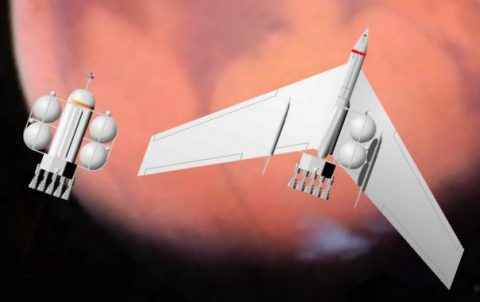
December 4, 1957: The third Disneyland program on space, Mars and Beyond, is broadcast.
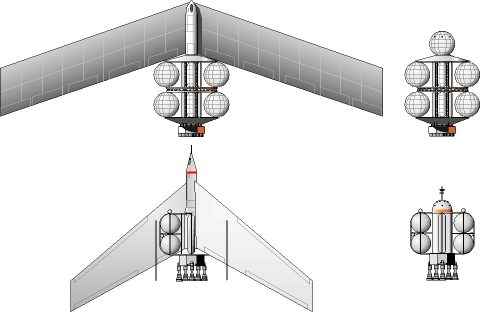
December 5, 1957: From an NCS (National Security Council) Memorandum:
Secretary Dulles said that he was about to be obliged to leave the meeting and, before doing so, he had a word to say about the postponement, yesterday, of our attempt to launch our first scientific satellite. He earnestly hoped that, in the future, we would not announce the date, the hour, and indeed the minute, that we were proposing to launch our earth satellite, until the satellite was successfully in orbit. Speaking very earnestly, Secretary Dulles said the effect of the publicity of the last few days, culminating in the final decision to postpone the attempt to launch our first earth satellite, had had a terrible effect on the foreign relations of the United States.
The President [Eisenhower] commented that he was all for stopping such unfortunate publicity, but he had no idea how we could stop it...

December 6, 1957: The US Navy's first attempt at launching a Vanguard satellite suffers a spectacular televised failure.
December 6, 1957: Memorandum From the Acting Secretary of Defense (Quarles) to the President [Eisenhower]:
The Director of Guided Missiles has provided the following preliminary report concerning today's unsuccessful Vanguard firing:
The countdown for the TV-3 Vanguard launching on 6 December 1957 was quite normal, after an early hold near the beginning of the count. All components appeared to be working correctly. At 1145, countdown was completed, and the vehicle lifted off the stand. After two seconds, it settled back on the pad apparently due to loss of thrust in the first stage motor. It fell over, and burst into flames. Both the first and second stages were destroyed, and the third stage was thrown clear without igniting.
A preliminary study of the instrumentation records, by the Naval Research Laboratory personnel, has been made and, at last report, the cause of the accident had not been ascertained with certainty. For safety reasons, a close inspection of the vehicle and launching pad had not been completed at last report. As far as yet determined, there has been only limited damage to the launching pad. No personnel were injured. Unless more substantial damage to the launching pad is discovered, in further inspection, the back-up TV-3 vehicle will be mounted on it, and should be ready for launching before the end of the calendar year. Barring unforeseen delays, the Navy still expects to adhere to its previous launching schedules for the full scale satellite. We will furnish a more complete report as soon as necessary details are available.
December 6, 1957: Memorandum from the President's Special Assistant for Science and Technology (Killian) to the President [Eisenhower]:
It was agreed that, henceforth, release of information by Government personnel concerning satellite tests would be centralized, and controlled directly from Mr. Snyder's office in DOD. This will be done, not to deprive the press of proper information, but rather to permit more orderly handling of information and statements about tests. DOD will also attempt to make improper observations and eavesdropping more difficult at Patrick, but [prospects of success appear] limited...
December 11, 1957: From an NCS (National Security Council) Memorandum:
Mr. Allen (USIA) said, the recent failure of the test had subjected the U.S. to damaging ridicule overseas. Our position at the moment was undignified and damaging, and reflected a dangerous lack of discipline. One trouble was that the Guide Lines were directed toward a purely scientific experiment. Since the Russian ICBM announcement, and the successful launching of Sputnik, it was no longer possible to treat the tests in this light. Rather, they had become a part of psychological warfare and competition...
December 17, 1957: Circular Airgram: From the United States Information Agency to All Principal United States Information Service Posts: INFOGUIDE: The Post-Sputnik Posture of the United States and the Free World:
1. Recent Soviet success, in the field of outer space rocketry, has increased Soviet prestige and credibility overseas, while reducing public confidence in US leadership. The Soviets have sought to exploit their gains in world opinion, by increased efforts at political and economic penetration, and continued efforts, in disarmament and other fields, to promote a bilateral US-USSR approach to negotiation, in hopes of splitting the US from its allies.
2. Against this background, it is especially important now, and in the period immediately ahead, that the US maintain a public posture, that effectively conveys the idea that America and the free world are united and strong--militarily, politically, economically and morally--but that, at the same time, we are proceeding solidly to increase and consolidate that strength in ways that will improve free world security and decrease the danger of war...
January 16, 1958: With the Soviets far ahead in space capability, US Secretary of State Dulles proposes that any activity in space be controlled by an international commission. (Fleming)
January 31, 1958: In response to the launch of the Soviet satellite Sputnik 1, but officially as part of the United States program for the International Geophysical Year, the US Army launches Explorer 1, at Cape Canaveral Air Force Station. It is America's first satellite, with a total weight just shy of 31 paltry pounds, in contrast to Sputnik's 1,120 pounds. Von Braun's team of German rocket scientists is predominantly responsible for its development. Von Braun himself monitors the launch from a communications room in the Pentagon, in the company of the Secretary of the Army and a gathering of top scientists and generals.
1958 Science Fact Article: International Geophysical Year Roundup by Willy Ley.
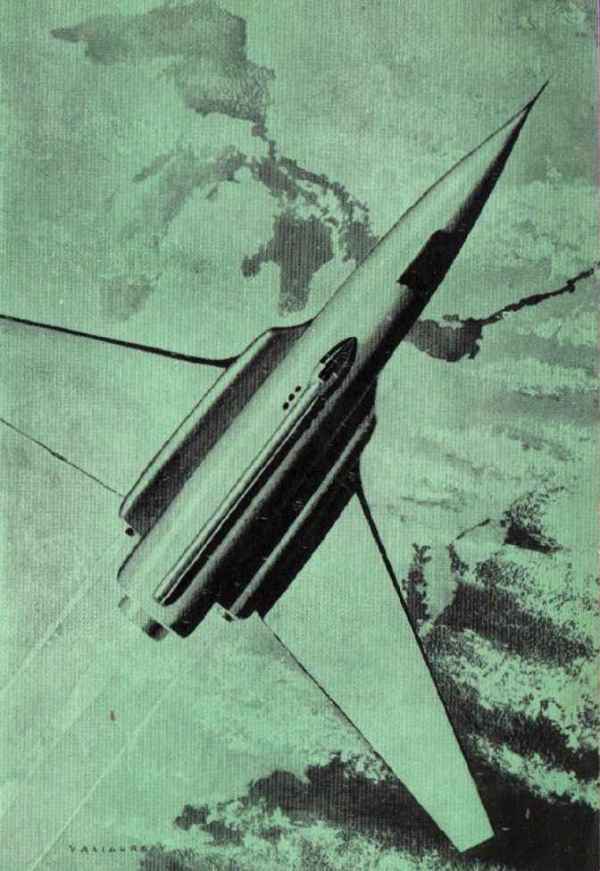
February 1958: Von Braun testifies before a congressional committee:
In the field of satellite and moon rockets, we need a well planned, long-range national program which makes maximum use of rocket hardware . . . . emerging from our ballistic missile and supersonic aircraft programs. This program must be backed up by a firm budget, which permits its steady execution over a period of several years. There is a crying need for more money, for basic and applied research in these areas, and for development of bigger booster engines . . . .
[While there are] adequate research funds . . . available for clearly defined weapons systems, there is never enough to "advance the art." A typical example is that we don't have a really powerful rocket engine today, simply because none of our present crash missile programs requires it. But in order to beat the Russians in the race for outer space, we absolutely need it, and the development and perfection of such an engine requires several years . . . .
Herein lies the real threat to our security, and only the immediate enactment of a well-planned, determined United States space flight program, covering all aspects of unmanned and manned flights through outer space can neutralize it.
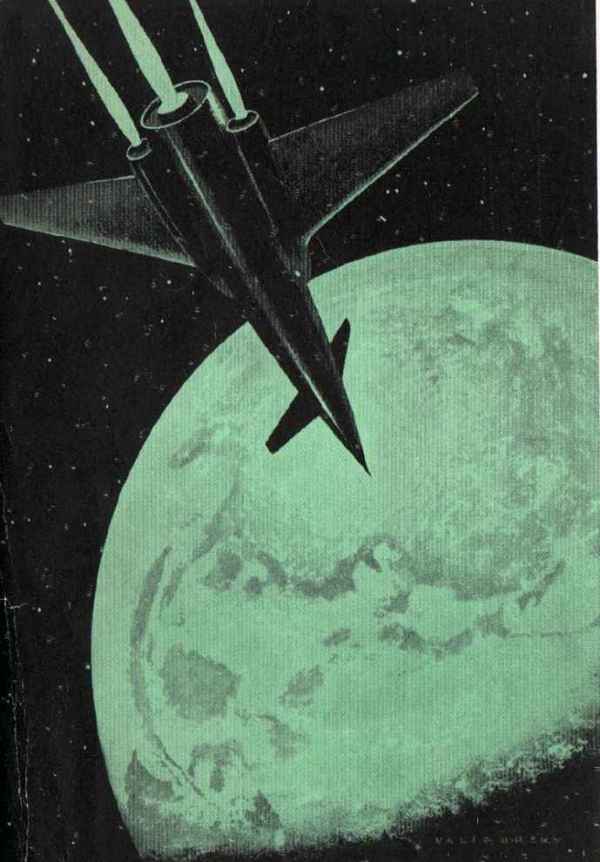
February 4, 1958: Von Braun meets President Eisenhower for the first time, at a White House dinner, to celebrate the successful launching of Explorer I. Von Braun, who attends in a rented tux, is dismayed when he discovers that the rental includes only a black tie. From his hotel room, he calls Eisenhower's press secretary, James Hagerty, and explains his problem. Hagerty assures him that a white tie will be found for him, and von Braun does indeed find the tie waiting for him, when he arrives at the White House. However, Eisenhower arrives late at the dinner, explaining that he could not find his white tie at the last moment, and apologizing that he was forced to wear a black one.
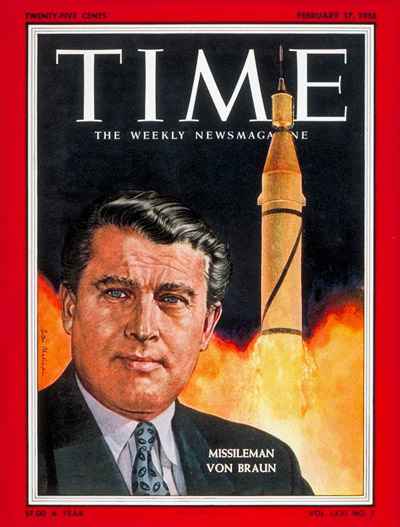
February 17, 1958: A feature article profiling von Braun, Reach for the Stars, is published in TIME Magazine:
. . . . Army brass marched with a color guard into a Capitol Hill hearing room to present a new service flag to the House Military Appropriations Subcommittee. Patrols of Army public-relations officers prowled Pentagon corridors, passing out word that, given the chance, the Army could develop a rocket motor to put a 15-ton satellite into space with a man aboard. The Air Force stood that sort of talk as long as it could, then leaked a story about using its Thor intermediate-range ballistic missile to put up a 1,000-lb. satellite as early as June. The Army promptly upped the ante to 1,500 lbs.--and the Pentagon's inter-service storm signals were flapping furiously.
A Broomstick Would Do. Yet, for all the rivalry, hard-working servicemen and civilian specialists, along the whole broad front of U.S. missilery, felt a new nearness to space as Explorer radioed back its readings. And of the legions of scientists, generals, admirals, engineers and administrators, at work on missiles and man-made moons, German-born Wernher von Braun, 45, best personified man's accelerating drive to rise above the planet. Von Braun, in fact, has only one interest: the conquest of space, which he calls man's greatest venture. To pursue his lifelong dream, he has helped Adolf Hitler wage a vengeful new kind of war; has argued against bureaucracy in two languages; and [has] campaigned against official apathy and public disbelief, on two continents, through most of his adult years.
A robust (5 ft. 11 in., 185 Ibs.), hearty man with a booming laugh, and a frank manner, he can be both ruthless and devious in his striving for space. To some, Von Braun's transfer of loyalty from Nazi Germany to the U.S., seemed to come too fast, too easy. Von Braun's critics say he is more salesman than scientist...
March 1958 Science Fact Article: So You Want To Go To The Moon.
March 14, 1958: Von Braun testifies before the Elliot Committee on education and labor. From his opening statement:
The Communist threat to the free world extends far beyond armies and politics. It involves every aspect of our way of life: religion, economics, industry, science, technology, and education . . . . [The problem brought to our attention by Sputnik is that] the [Soviet] state-controlled educational system is turning out competent engineers and scientists in greater numbers than ours . . . .
[Solutions:] First--we must recruit more young people into scientific and technical careers. Second--we must make these careers more attractive and induce more young people to select them. Third--this involves inspiration, at home as well as in school; competent teachers, adequate laboratories and libraries; assistance to those who require it, to finance undergraduate study at least, provision of fellowships or other stipends, to encourage graduate study.
Taking questions from the congressmen, von Braun is asked his opinion of the poor treatment meted out to J. Robert Oppenheimer, the man who had led the team that developed the atomic bomb. In 1954, Oppenheimer's loyalty had been questioned, and while he was subsequently ruled loyal by an AEC (Atomic Energy Commission) panel, he was deemed a security risk, and excluded from government research. Oppenheimer's congressman, Representative Frank Thompson Jr. of New Jersey, questions Von Braun:
Representative Thompson: Don't you think it is somewhat tragic that because of political considerations, the country has been deprived of the services of Dr. Oppenheimer?
Von Braun: Very much so. Particularly, the circumstances under which he was dismissed, hurt the whole scientific community very badly.
Representative Thompson: I agree. I think it has been an outrage.
Von Braun: Yes, the way the whole thing was handled [was an outrage].
May 1958 Science Speculation Strip: Outer Space by Pat Masulli.
July 20, 1958: The first segment of a three-part biography of von Braun is published in The American Weekly, a magazine inserted into the folds of Sunday newspapers nationally: Space Man—the Story of My Life by Wernher von Braun as told to Curtis Mitchell.
August 15, 1958: The Advanced Research Project Agency (ARPA) of the Department of Defense approves 10 billion dollars to the von Braun team to develop a booster rocket based on a cluster of eight Jupiter C rocket engines. (Piszkiewicz)
October 1, 1958: The National Advisory Committee on Aeronautics is dissolved. NASA (the National Aeronautics and Space Administration) replaces it.
September 1958 Science Fact & Fiction Article: The Face on Mars.
September 1958 Science Fact Article: Why Mars?
October 5, 1958: From the New York Times:
A year ago yesterday Moscow electrified the world by launching Sputnik I and thus taking the first giant step into space. The Soviet achievement—a scientific, technical and military demonstration of growing Russian power—shook American complacency and led in Washington to a re-evaluation, reorganization and speed-up of our space and missile programs. The excitement of a year ago, almost frenetic in its quality, has been succeeded by somewhat calmer judgments; some critics of Administration leadership say complacency has returned.
In the past twelve months the United States has developed new agencies for space exploration and has speeded up some of its military rocket development programs, although the military missile organization—upon which now depends much of our space development program—remains virtually unchanged. The great question confronting Washington is whether or not our present efforts are adequate—not so much to meet the challenge of today, but the increasing Soviet potential of tomorrow. Those who fear we may lag in the space and missile race are particularly concerned about what they feel is the limited imagination and limited budget of our space program—a program which has barely started—and about the dichotomy between civilian (scientific) and military projects.
October 7, 1958: T. Keith Glennan, the first Administrator of NASA, approves the Mercury project.
December 29, 1958: North American Aviation is awarded a contract to design and build Little Joe boosters for test flights.
January 2, 1959: The Russian satellite Luna 1 is launched in an attempt to hit the Moon. While missing the Moon, it does become the first man-made object to enter into an orbit around the Sun.
1959 Science Fact Article: Orbit Around The Sun by Willy Ley.
January 8, 1959: NASA asks the Army to provide the reliable Redstone booster for the Mercury Program.
January 17, 1959: President Eisenhower presents von Braun with a Distinguished Federal Service Medal, the highest award given to civil servants. Von Braun uses the opportunity, with Eisenhower standing nearby, to tell the press that the ABMA in Huntsville could use another 50 to 60 million dollars. The fiscally conservative Eisenhower successfully resists the suggestion. (Piszkiewicz)
January-February 1959: McDonnell Aircraft Corporation is chosen to be prime contractor for Project Mercury, and is awarded a contract for 12 spacecraft.
1959 Science Fact Article: The Atlantic Missile Range by Willy Ley.
April 9, 1959: NASA selects the USA's first astronauts, "the Mercury Seven."
April 14, 1959: Hollywood movie producer Charles M. Schner presents a first draft of a screenplay--I Aim at the Stars--for a proposed film of von Braun's life, to Gordon L. Harris, Huntsville's Public Information Officer. The movie project is eventually approved, but the movie will have problems from the beginning. Its eventual director, J. Lee Thompson will later comment:
Von Braun and I disliked each other on sight. After a time I grew almost to like him: almost, but not quite. (Piszkiewicz)

September 12, 1959: Luna 2, a Russian satellite that has been sterilized to avoid contaminating the Moon with terrestrial bacteria, is launched.
September 13, 1959: Luna 2 becomes the first man-made object to hit the Moon.
September 16, 1959: The US Congress authorizes the issuance of a gold medal, in honor of Professor Robert H. Goddard.

October 4, 1959: Luna 3 goes in orbit around the Moon, photographing 70 percent of the never-before-seen far side.
October 21, 1959: President Eisenhower orders the transfer of the Development Operations Division of ABMA at Redstone--4,670 civil service employees and the 1,840 acres of land--to NASA.
December 4, 1959: From an Address by Allen W. Dulles, the Director of Central Intelligence:A decade ago Moscow was speaking to us in threatening terms because we were giving aid overseas to meet the danger of economic breakdown and communist takeover in large parts of Europe. Now they propose to compete with us on a worldwide basis in the field of overseas aid and trade, hoping to win over the uncommitted nations of the world. Then, though they had no atomic bombs, the Soviet were using the threat of their great conventional forces to help undermine Greece and Turkey and then later to menace the Free World in Berlin and Korea. Now, while they preach coexistence and economic and industrial competition with the West, they also, on occasions, this week in fact, rattle the threat of ballistic missiles...
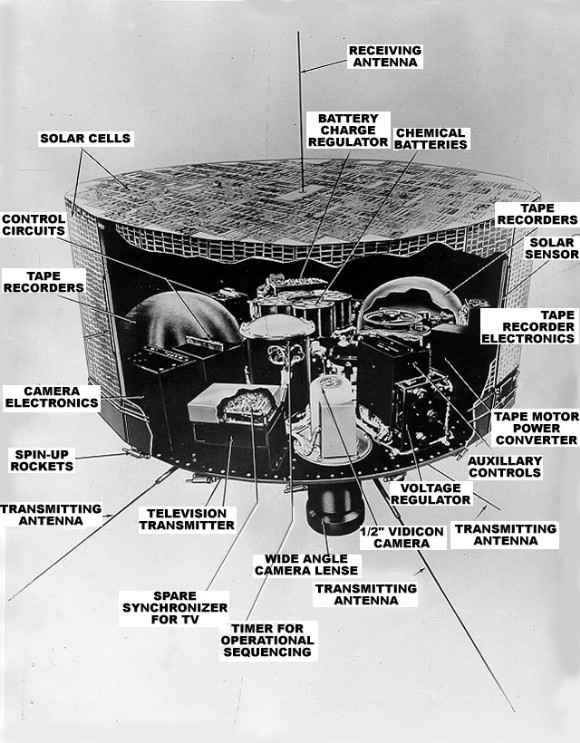
April 1, 1960: The first successful weather satellite, Tiros 1, is launched by the US.
From the memoirs of Nikita Khrushchev, Khrushchev Remembers, as translated by Edward Crankshaw: I think I was right to concentrate on military spending, even at the expense of all but the most essential investments in other areas. If I hadn't put such a high priority on our military needs, we couldn't have survived. I devoted all my strength to the rearmament of the Soviet Union. It was a challenging and important stage of our lives. Now that I'm living with my memories and little else, I think back often to that period when in a creative surge forward we rearmed our Soviet Army. I'm proud that the honor of supervising the transition to the most up-to-date weaponry fell on me as the Chairman of the Council of Ministers and the First Secretary of the Central Committee.
Our potential enemy—our princip[al], our most powerful, our most dangerous enemy—was so far away from us that we couldn't have reached him with our air force. Only by building up a nuclear missile force could we keep the enemy from unleashing war against us. As life has already confirmed, if we had given the west a chance, war would have been declared while Dulles was alive. But we were first to launch rockets into space; we exploded the most powerful nuclear devices; we accomplished those feats first, ahead of the United States, England, and France. Our accomplishments and our obvious might had a sobering effect on the aggressive forces in the United States, England, France, and, of course, inside the Bonn government. They knew that they had lost their chance to strike at us with impunity.
May 15, 1960: While Nikita Khrushchev and Dwight D. Eisenhower confer at a summit meeting, the Soviets launch their first satellite capable of housing human beings and designed to be recoverable. Khrushchev's triumph soon becomes an embarrassment, however. While the launch goes well, the recovery system fails and, instead of re-entering the earth’s atmosphere, the Sputnik is bounced into a higher orbit and is lost.
From a 11/17/71 interview of Dr. Wernher von Braun conducted by Roger Bilstein and John Beltz: There is probably less competition in the Soviet launch vehicle program than in this country. The relationship between the space people, the space program people, and the Soviet Union, and the rocket people, is probably best compared with the relationship we have between these two groups in this country during the Gemini program where, as you will remember, NASA built spacecraft but went to the Air Force to request Titan II launch services for Gemini spacecraft.
The launching itself of Gemini spacecraft was done largely by blue-suiters. And it was only in the Apollo program that we brought a launch vehicle into the process that had no military history at all. Remember, even the Mercury used Atlas launch vehicles, and the Redstone rocket preceded Atlas very early—Alan Shepard's and Gus Grissom's flights had a military history. The Saturn V was really the first launch rocket that was a baby of NASA and not the military—a military child.
Now the entire family of Soviet launch vehicles up to this point was really developed under military auspices. They have the so-called Strategic Rocket Command in the Soviet Union, comparable to our Strategic Air Command, and they are really the sole owners of rocketry, you might say. And the space people go to them for booster service, just like NASA went to the Air Force for Atlas' and Gemini’s.
The industrial complex—if that's what you want to call it—state-controlled economy undoubtedly doesn't have as many facets as the American aerospace industry. In other words, they don't have their Boeing’s, and North American Rockwell’s, and Douglas’s, and so forth, to build competing systems. But it was, and I believe still is, a more monolithic operation. With that I am not saying there's no competition at all. I think there's every indication that within that monolithic industrial structure there are some competing teams. You see that in their aviation industry . . . .
Nevertheless, I think it is far more monolithic—and that also means that, shall we say, there are less checks and balances in this. In NASA, you could always tell the Boeing people, "Look, the Douglas people brought something in here which, in our opinion, greatly enhanced the liability of something," and vice versa. So the government was in the fortunate position that it could effectively cross-feed ideas that came out of these various pots.
When you have a very monolithic organization, that is one, shall we say, like a military establishment, you have less and less of that. There is, at the end, one man responsible for all these things. You know, the Russians always mysteriously refer to "the chief constructor," or "the chief engineer," whoever that man is... We have never run the Saturn V program like that in NASA. I think we considered ourselves far more like a stock exchange of good ideas where we felt we picked the best things out of all these things and cross-fed them for maximum benefit of the whole.
June 2, 1960: Maria von Braun gives birth to the couple's third child, a son, Peter Constantine. (Piszkiewicz)
1960: A decade after Robert H. Goddard's estate, with backing from the Guggenheim Foundation, had sued the US government for patent infringement, the suit is finally settled. Goddard's widow and the Guggenheim Foundation share a one million-dollar settlement. (Piszkiewicz)

June 21, 1960: Columbia Pictures Corporation presents an advance screening of I Aim at the Stars in the auditorium of the new Senate Office Building. The film stars Curt Juergens, and the cast is composed of mostly unknown character actors. The audience, made up mostly of lawmakers and other carefully selected individuals, applauds politely after the showing, but no one is very enthusiastic about the results, including, reportedly, von Braun. No-one, who knows the scientist personally, recognizes him on the screen and, the consensus is that, the film is an example of Hollywood propaganda, and not a serious biography. (Piszkiewicz)

July 1, 1960: The Development Operations Division of ABMA at Redstone becomes the Marshall Space Flight Center, named after Eisenhower's World War II commander, George C Marshall. The entire facility is placed under the direction of von Braun. (Piszkiewicz)
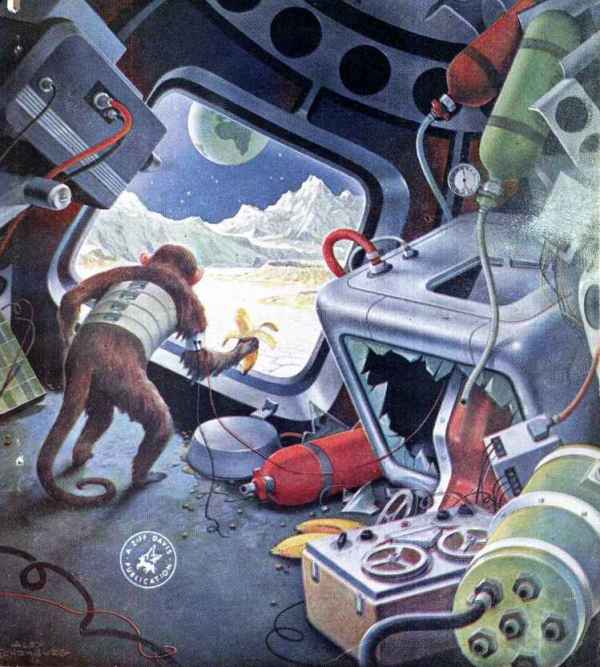
July 28, 1960: Another attempt is made by the Soviets to launch a satellite capable of housing humans, with two dogs, Chayka and Lisicha, on board. This time the recovery system functions perfectly and the dogs are safely recovered.
September 8, 1960: President Eisenhower visits Huntsville, to dedicate the Marshall Space Center. Von Braun shows Ike a Saturn I booster, and invites the president to ride the elevator to the third level, for a closer look. Eisenhower ignores the objections of his Secret Service detail, which is of the opinion that the tower is unsafe for a president, and accompanies von Braun. Eisenhower seems to very much enjoy the tour, considering NASA to be one of his administration's greatest accomplishments. (Piszkiewicz)
September 28, 1960: I Aim at the Stars has its official premiere at Loewe's Theater, in Washington, DC. It is written by Jay Dratler, based on a story by George Froeschel, H. W. John, and Udo Wolter; and directed by J. Lee Thompson. The film, whose original British release title is simply Wernher von Braun, will be picketed by angry Londoner's who still remember the V-2 attacks of the war. In Germany, where the film is titled Ich greife nach den Sternen (I reach for the Stars), moviegoers in Munich boo the production, especially when images of American rockets and missiles fill the screen. In Italy, the film is released as Alla Conquista dell' Infinito. The film has a very short and unimpressive showing everywhere. (Piszkiewicz)
October 17, 1960: TIME Magazine reviews I Aim at the Stars:
It explodes in a splatter of platitudes about the moral dereliction of the scientific community--personified in von Braun. The movie makers, nervous perhaps about possible public reaction to von Braun's Nazi record, and the responsibility he shares for the V-2 attacks on London, have leaned over backwards to stress his war guilt, with the unhappy result that the hero comes off as a jolly accomplice in mass murder; an affable fanatic who cares everything about rockets, and nothing about the people they happen to kill. In the end, his moral indifference is shown to be dubiously justified by his scientific success. Von Braun possibly has grounds for a libel suit, but then he might do better to ignore the picture. So might everybody else.
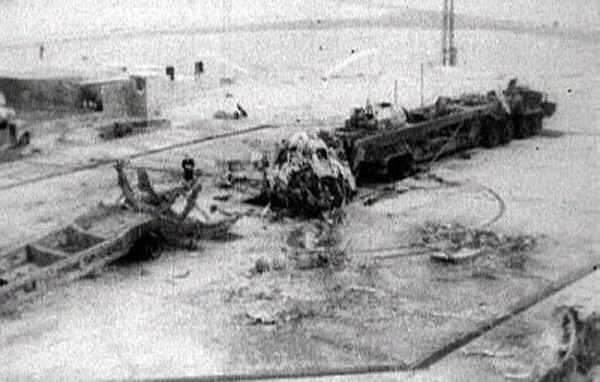
October 24, 1960: The Nedelin Disaster occurs when a prototype of the Soviet R-16 ICBM missile, which is being prepared for a test flight, explodes on the launch pad. The official death toll is 90, but estimates are as high as 150, with 120 being the generally accepted figure. Despite the magnitude of the disaster, news of it will be covered up for many years. The Soviet government will not acknowledge the event until 1989. Strategic Rocket Forces Marshal Mitrofan Nedelin, the commander of the R-16 development program, is among those killed in the explosion and fire. The subsequent delay to the R-16 program will spur the USSR toward the development of more effective ICBMs and will spark Khrushchev's decision to install IRBM's in Cuba.
October 25, 1960: A story in the Soviet newspaper Pravda (Russian for 'Truth') announces that Marshal Mitrofan Nedelin has perished in an unfortunate plane crash.
January 17, 1961: From Eisenhower's Farewell Address to the Nation:
Today, the solitary inventor, tinkering in his shop, has been overshadowed by task forces of scientists in laboratories and testing fields. In the same fashion, the free university, historically the fountainhead of free ideas and scientific discovery, has experienced a revolution in the conduct of research. Partly because of the huge costs involved, a government contract becomes virtually a substitute for intellectual curiosity...
1961 Science Fact Article: Cosmic Lifeboat.
January 20, 1961: John F. Kennedy (JFK) becomes the 35th President of the United States.
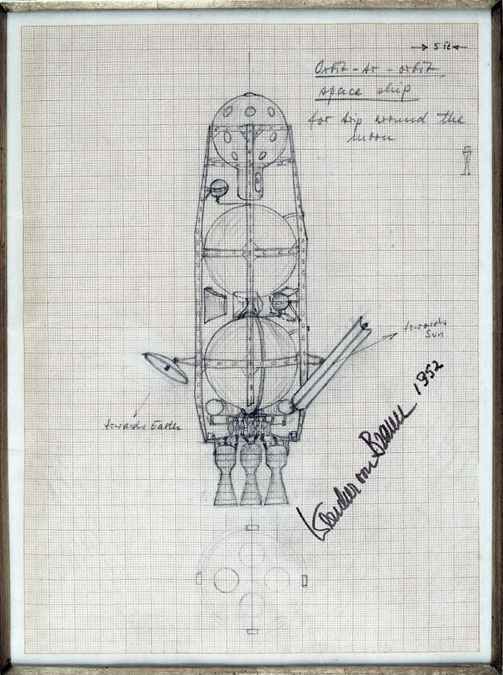
January 21, 1961: Von Braun is awarded his only documented patent, for a "Rocket Propelled Missile." While he claimed that he had received ten patents during his years of work in Germany, no proof of any had ever been found. (Piszkiewicz)
1961 Science Fact Article: Assembling a Space Station by Frank Tinsley.
April 20, 1961: JFK sends a five-page memorandum to Vice President Johnson, whom he had appointed the chairman of the National Aeronautics and Space Council (NASC). Excerpt:
Do we have a chance of beating the Soviets by putting a laboratory into space, or a trip to the moon, and back, with a man? Is there any other space program which promises dramatic results in which we could win?

April 24, 1961: Vice President Johnson (center), in response to JFK's query concerning possible space missions, convenes a meeting with NASA administrator, James Webb (right); science advisor, Jerome Wiesner; and representatives from the Army, Navy, and NASA. Von Braun (left) spoke for NASA. Jerome Wiesner would later write:
Johnson went around the room saying, "We've got a terribly important decision to make: Shall we put a man on the moon?" Everybody said Yes, and he said, "Thank you" and reported to the president that the panel said we should put a man on the moon.
May 5, 1961: The USA becomes the second nation to achieve manned spaceflight, as NASA launches a Mercury-Redstone 3 rocket, piloted by Mercury astronaut Alan B. Sheppard. An estimated 100 million Americans watch on television, or listen on their radios, as the tiny Mercury capsule, propelled by a Redstone rocket--originally designed by Wernher von Braun and his team as a weapon of war--propels Sheppard into space. He travels 115 miles up, and 302 miles downrange on its fifteen-minute flight.
1961 Science Fact article: Science Fiction is Too Conservative.
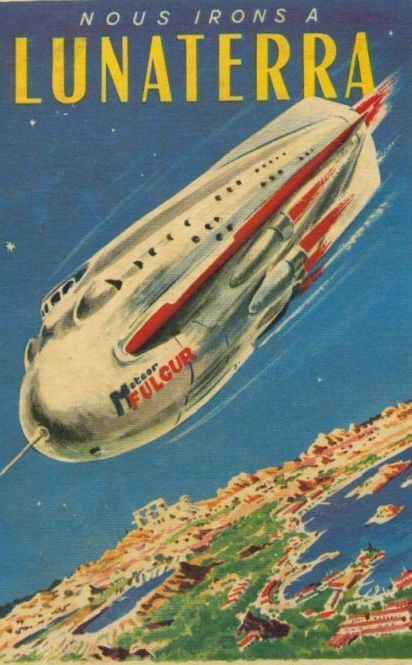
May 25, 1961: JFK, before a special address to a joint session of Congress:
I believe that this nation should commit itself to achieving the goal, before this decade is out, of landing a man on the Moon and returning him safely to the Earth. No single space project in this period will be more impressive to mankind, or more important in the long-range exploration of space; and none will be so difficult or expensive to accomplish. (Full Text.)
August 6, 1961: Cosmonaut Gherman Titov spends an entire day orbiting the Earth in Vostok 2.
1961 Science Fact Article: Progress Report: Super V-2 by Harry Stine.
December 7, 1961: NASA announces the successor to Project Mercury, Mercury Mark II. It will be re-christened Project Gemini, on January 3, 1962.
1962 Science Fact Article: Are We Going To Build a Space Station? by Willy Ley.
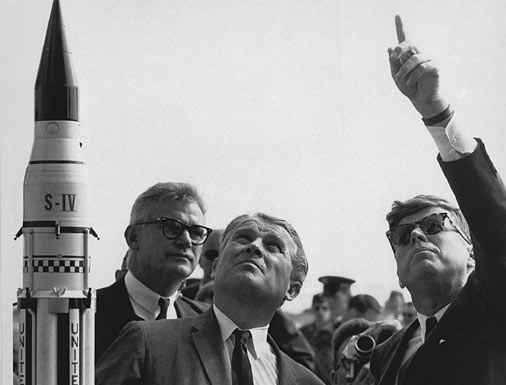
January 11, 1962: President Kennedy delivers his second State of the Union address:
With the approval of this Congress, we have undertaken in the past year a great new effort in outer space. Our aim is not simply to be first on the moon, any more than Charles Lindbergh's real aim was to be the first to Paris. His aim was to develop the techniques of our own country, and other countries, in the field of air and the atmosphere; and our objective in making this effort--which we hope will place one of our citizens on the moon--is to develop in a new frontier of science, commerce, and cooperation; the position of the United States and the Free World.
This Nation belongs among the first to explore it, and among the first--if not the first--we shall be. We are offering our know-how and our cooperation to the United Nations. Our satellites will soon be providing other nations with improved weather observations. And I shall soon send to the Congress a measure to govern the financing and operation of an International Communications Satellite system, in a manner consistent with the public interest...
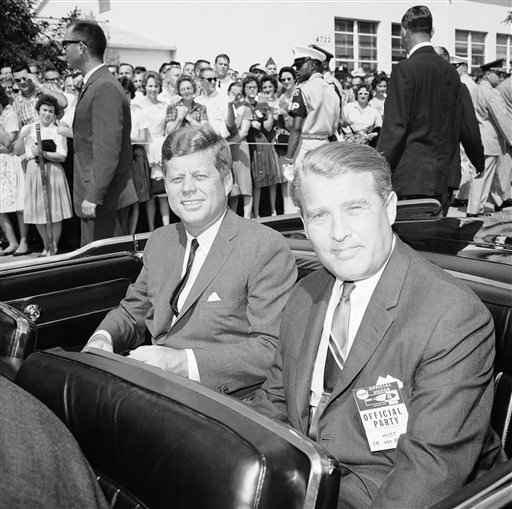
September 12, 1962: President John F. Kennedy, at Rice University:
Yet the vows of this Nation can only be fulfilled if we in this Nation are first, and, therefore, we intend to be first. In short, our leadership in science and in industry, our hopes for peace and security, our obligations to ourselves as well as others, all require us to make this effort, to solve these mysteries, to solve them for the good of all men, and to become the world's leading space-faring nation.
We set sail on this new sea because there is new knowledge to be gained, and new rights to be won, and they must be won and used for the progress of all people. For space science, like nuclear science and all technology, has no conscience of its own. Whether it will become a force for good or ill depends on man, and only if the United States occupies a position of pre-eminence can we help decide whether this new ocean will be a sea of peace or a new terrifying theater of war.
I do not say the we should or will go unprotected against the hostile misuse of space any more than we go unprotected against the hostile use of land or sea, but I do say that space can be explored and mastered without feeding the fires of war, without repeating the mistakes that man has made in extending his writ around this globe of ours. There is no strife, no prejudice, and no national conflict in outer space as yet. Its hazards are hostile to us all. Its conquest deserves the best of all mankind, and its opportunity for peaceful cooperation many never come again. But why, some say, the moon? Why choose this as our goal? And they may well ask why climb the highest mountain? Why, 35 years ago, fly the Atlantic? Why does Rice play Texas?
We choose to go to the moon. We choose to go to the moon in this decade and do the other things, not because they are easy, but because they are hard, because that goal will serve to organize and measure the best of our energies and skills, because that challenge is one that we are willing to accept, one we are unwilling to postpone, and one which we intend to win, and the others, too.
1962 Science Fact Article: The End of the Jet Age by Willy Ley.

1963 Science Fact Article: For Your Information by Willy Ley.

1963: Geheimnis von Huntsville (The Secret of Huntsville), by Julius Mader is published in East Berlin. The book reveals, for the first time, the facts about von Braun's activities at Mittelwerk, and his SS membership. The book is never translated into English, and attracts little attention in the US, being dismissed as Communist propaganda.

June 16, 1963: Valentina Tereshkova becomes the first woman in space when the USSR launches Vostok 6.
November 22, 1963: President John F. Kennedy is shot and killed in Dallas, Texas. As a tribute, President Lyndon Johnson changes the name of the rocket launch site--Cape Canaveral--to Cape Kennedy. Although the name change will be approved by the United States Board on Geographic Names of the Interior Department in 1964, it is never popular in Florida, especially in the city of Cape Canaveral. In 1973 the state will pass a law restoring the former 400-year-old name.
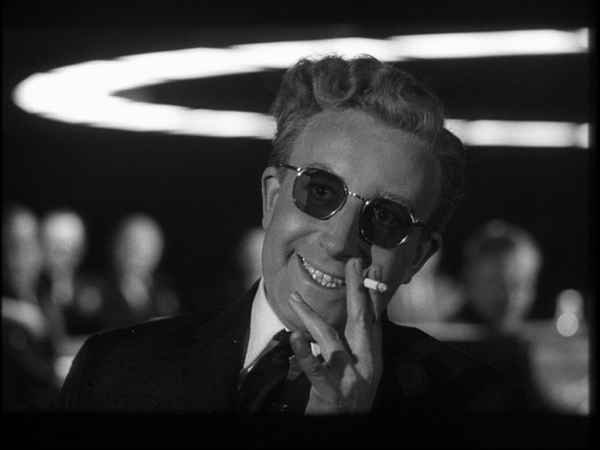
January 29, 1964: Columbia Pictures releases the black comedy, Dr. Strangelove or: How I Learned to Stop Worrying and Love the Bomb. Directed by Stanley Kubrick, the film is a Cold War spoof, and one of the top-rated comedy movies of all time. The story revolves around a United States Air Force general, who orders a first strike nuclear attack on the Soviet Union. The film's opening frames feature this disclaimer:
It is the stated position of the United States Air Force that their safeguards would prevent the occurrence of such events as are depicted in this film. Furthermore, it should be noted that none of the characters portrayed in this film are meant to represent any real persons living or dead.
The title character, Dr. Strangelove, is a former Nazi physicist, serving as science advisor to the president of the United States. He is prone to accidentally addressing the President as Mein Fuehrer during moments of stress. Despite the disclaimer, Strangelove is an amalgamation of RAND Corporation strategist Herman Kahn, atom scientists Edward Teller and John von Neumann, and Wernher von Braun.
August 6, 1964: The Washington Post reports on a story published in the Soviet newspaper Izvestia:
Izvestia - attacked American rocket expert Wernher von Braun, for "creating inhuman conditions" among workers at an underground Nazi rocket base in Poland, [sic] which he reportedly headed during World War II. Von Braun, Izvestia said, did so "to carry out the promise given to Hitler of a miracle weapon."
1965: Wernher Von Braun, by Tom Lehrer, is released:
Gather round while I sing you of Wernher von Braun
A man whose allegiance is ruled by expedience
Call him a Nazi, he won't even frown
"Ha, Nazi schmazi," says Wernher von Braun
Don't say that he's hypocritical
Say rather that he's apolitical
"Once the rockets are up, who cares where they come down
That's not my department," says Wernher von Braun
Some have harsh words for this man of renown
But some think our attitude should be one of gratitude
Like the widows and cripples in old London town
Who owe their large pensions to Wernher von Braun
You too may be a big hero
Once you've learned to count backwards to zero
"In German oder English I know how to count down
Und I'm learning Chinese," says Wernher von Braun
From The Modern Age, edited (1968) by Sir Julian Huxley: The Soviet Union ushered in the Space Age with the launching of Sputnik I on October 4, 1957. On January 31, 1958, the United States made it a Space Race with the successful launching of Explorer I. At long last, after countless centuries of wishful imaginings, man's dream of traveling to the moon—and beyond—seemed on the verge of fulfillment.
The Soviets began their space efforts with extremely powerful rockets capable of launching heavy spacecraft into orbit. In contrast, the United States space program began with relatively small, lightweight spacecraft requiring no such powerful boosters. But during the next ten years, the United States closed this technical gap with the Soviet Union and, in fact, leaped ahead by a large margin in many areas of space exploration. Although the Soviet Union scored many 'firsts' in the early days of space flight, the United States holds almost every major record and an even more imposing number of firsts.
To a great degree, space flight owes its success and rapid progress to the Germans. Large-scale rocket research began after World War II with captured V-2 rockets. These rockets had a horizontal range of nearly 200 miles and a vertical range of about 100 miles. At lift-off they weighed almost 13 tons. After the war, some of the German missile scientists went to the Soviet Union to carry on further research. Others went to the United States to continue their work. One of the most famous is Dr. Wernher von Braun, who heads the George C. Marshall Flight Center in Huntsville, Alabama.
Although the Soviet Union succeeded in putting cosmonaut Yuri Gagarin into orbit in 1961, the United States soon managed to send two astronauts on suborbital flights in the same year. On February 20, 1962, astronaut John Glenn flew three times around the world in his Mercury spacecraft, Friendship 7. Three other Mercury flights were also undertaken. In the years which followed, the United States managed to build up an impressive record of success with projects Gemini and Apollo . . . . In a spectacular operation, American astronauts Borman, Lovell and Anders, in Apollo 8, orbited the moon 10 times, less than 70 miles from its surface . . . . Space history had been made and the landing of the first man on the moon was in sight.

March 18, 1965: Cosmonauts of the Voskhod 2 perform the first ever Space Walk (EVA--extra-vehicular activity).

October 23, 1965: After publishing a number of articles, favorable to von Braun, in Paris Match, the magazine receives stacks of mail, critical of the rocket scientist. Many of these letters are from members of a group called Friends of Deportees of the Dora-Ellrich Camps (Amicale des Camps de Dora-Ellrich). The letters point out that von Braun, being partly responsible for the suffering of the inmates at Dora, is hardly deserving of the celebrity status he has achieved. Von Braun answers his critics, in a defiant letter published in the magazine this day, stating that "As much as I understand their bitterness, I am appalled by their false accusations aimed at me." He points out that the US government had examined his background, and given him a clean bill of health; and that he is in no way responsible for the crimes of the Nazis. "I felt ashamed that things like this were possible in Germany," he claims, "even under a war situations [sic] where national survival was at stake." The editors of Paris Match are obviously satisfied with von Braun's denials, and the story soon disappears.
January 5, 1966: Sergey Korolyov dies in a hospital bed, from cancer, aggravated by a weak heart, and malpractice by his doctors. Under a policy initiated by Stalin, and continued by his successors, the identity of Korolyov had never been revealed to the Soviet public. The purported reason was to protect him from foreign agents from the United States. As a result, the Soviet people had never become aware of his accomplishments, until his obituary is published in the Pravda newspaper on 16 January 1966, showing a photograph of Korolyov with all his medals. His ashes are interred with state honors, in the Kremlin Wall. (Harford)
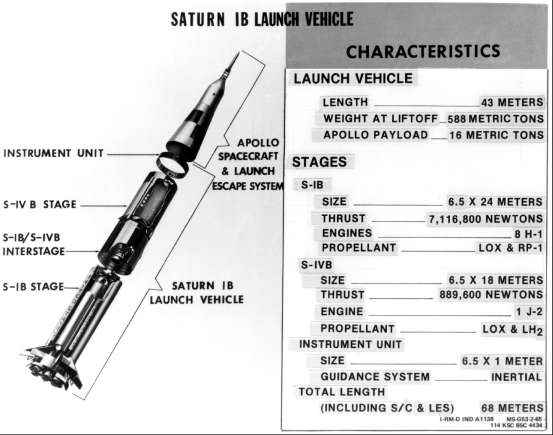
June 19, 1966: An article, Man on the Moon, appears in the Los Angeles Times, quoting von Braun:
Other journeys must follow [the first landing on the moon]. We must use the Saturn rockets, the Apollo spacecraft, and the launch facilities built up in Project Apollo--over and over again--to gain the fullest return for our investment. To make a one night stand on the moon, and go there no more, would be as senseless as building a locomotive and a trans-continental railroad, and then making one trip from New York to Los Angeles.
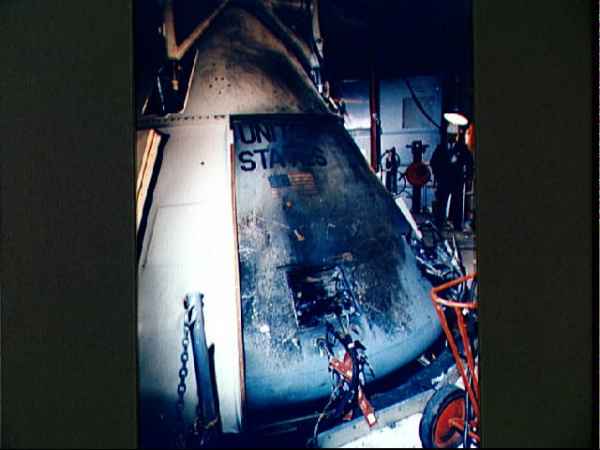
January 27, 1967: Apollo/Saturn-204 catches fire on the launch pad, during a pre-launch test of the spacecraft at Cape Canaveral. Command Pilot Virgil "Gus" Grissom, Senior Pilot Edward H. White, and Pilot Roger B. Chaffee all perish in the Command Module cabin, which contains an atmosphere of pure oxygen. The name Apollo 1, chosen by the crew, is officially assigned retroactively in commemoration of them.
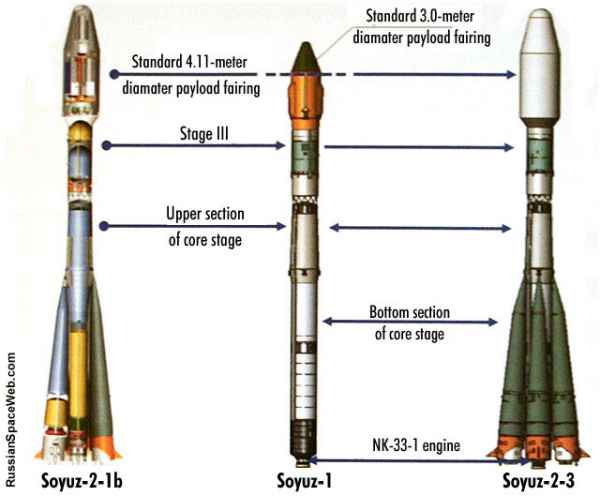
April 24, 1967: After orbiting the earth for a day in Soyuz-1, Cosmonaut Colonel Vladimir Komarov dies during his final descent, when his parachute lines tangle, causing his capsule to crash.
May 1968: From a letter to R. W. Reid by Wernher von Braun:
With the tight press censorship imposed by Hitler, the abuses of his regime were not nearly as visible to the average German as they were to an outsider who had free access to the international news media. For this reason, I must say, more by way of a statement than as an apology, that I never realized the depth of the abyss of Hitler's régime until very late and particularly after the war, when all these terrible abuses were first published.
I guess until about a year before the war's end I shared the feelings of most Germans that while Hitler was unquestionably an aggressor and a conqueror, that this put him more in a class with Napoleon than with the devil incarnate. While right from the beginning I deeply deplored the war and the misery and suffering it spread all over the world, I found myself caught in a maelstrom in which I simply felt that, like it or not, it was my duty to work for my country at war.
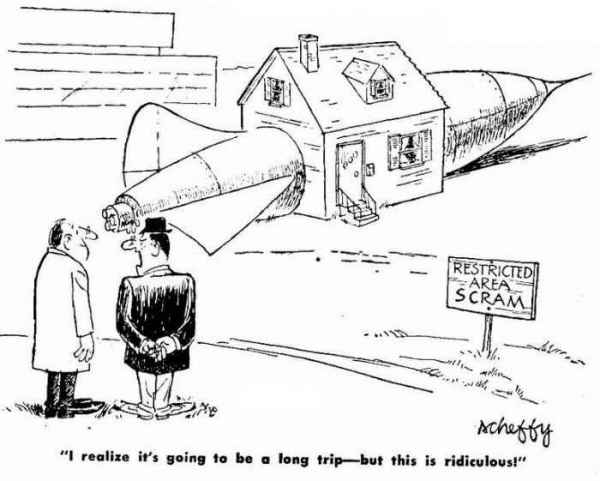
February 13, 1969: Newly elected President Richard Nixon establishes a Space Task Force to define America's long term goals in space. NASA administrator Thomas O. Paine, presidential science advisor Lee A. DuBridge, and Air Force Secretary Robert C. Seamans are appointed members, with Vice President Spiro Agnew as chairman. Thomas O. Paine doesn't think much of Nixon's choice of Agnew, saying of the VP: "His principal interest [in the space program] was in playing golf with the astronauts."
July 14, 1969: Less than a week before the launch of Apollo 11, a press conference is held at Cape Kennedy. From an account by author Norman Mailer:
Since he [von Braun] had … a big burly squared-off bulk of a body which gave hint of a methodical ruthlessness of more than one Russian bureaucrat, von Braun's relatively small voice, darting eyes, and semaphoric presentation of lip made it obvious he was a man of opposites. He revealed a confusing aura of strength and vulnerability, of calm and agitation, of cruelty and concern, phlegm and sensitivity, which would have given fine play to the talents of so virtuoso an actor as Rod Steiger. Von Braun had in fact something of Steiger's soft voice, the play of force and weakness which speaks of consecration and vanity, dedication and indulgence, steel and fat.
July 17, 1969: The New York Times prints the following correction:

July 19, 1969: Life Magazine sponsors a pre-launch party for the rich, famous, and powerful, at the Royal Oak Country Club near Cocoa Beach. When Life's publisher introduces Von Braun, he receives a standing ovation from the assembled big shots. An excerpt from his remarks:
What we are seeking in tomorrow's trip is indeed the future on earth. We are expanding the mind of man. We are extending this God-given brain and these God-given hands to their outermost limits and, in doing so, all mankind will benefit. All mankind will reap the harvest . . . . What we will have attained when Neal Armstrong steps down upon the moon is a completely new step in the evolution of man.
NASA administrator Thomas O. Paine, as quoted in Prescription For Disaster by Joseph J. Trent: I think most people felt that he [von Braun] had a damned unfortunate past, and nobody liked a Nazi ... but that he had kind of paid his dues, and that he really helped us get to the moon in developing the Saturn V, and showed himself to be a worthy citizen of this country, and that while we won't exactly forgive and forget, politeness dictates, at least, we won't get into a disgraceful knock down and drag out.

July 20, 1969: Neil Armstrong and Buzz Aldrin of Apollo 11 land on the Earth's moon, while astronaut Michael Collins orbits above. This and five subsequent Apollo missions will land, all told, 12 astronauts on the Moon, the last one in December 1972. This is a triumph of scientific exploration and, arguably, the greatest technological achievement in human history. Man on the Moon, the complete illlustrated story of Apollo 11.

From The Memoirs of Richard Nixon: For me the most exciting event in the first year of my presidency came in July 1969 when an American became the first man to walk on the moon. The moon landing was the culmination of a program begun a dozen years earlier after the Soviets launched Sputnik, the first man-made orbiting satellite. American public opinion was jolted at the thought of the Soviets in charge of outer space, but Eisenhower and most of his advisors were not so disturbed.
Sherman Adams, for example, told a predominantly Republican audience that the so-called satellite race was just "an outer space basketball game." I believe that this flippant remark was wrong in substance and disastrous in terms of public opinion. The next night I told an audience in San Francisco, "We could make no greater mistake than to brush off this event as a scientific stunt of more significance to the man on the moon than on men on Earth."
In cabinet and NSC meetings during this time I strongly advocated a sharp increase in our missile and space programs. Eisenhower finally came around to this view and approved a proposal; for manned space vehicles. While he justified this decision on military grounds, I felt that something far more basic was involved. I believe that when a great nation drops out of the race to explore the unknown, that nation ceases to be great. The manned space program was already well under way when President Kennedy captured the national imagination in 1961 by setting the goal of a moon landing by the end of the decade. President Johnson was an enthusiastic supporter of NASA, and under his administration the Apollo program made great strides . . . .
On Sunday night, July 20, Apollo VIII astronaut Frank Borman, Bob Haldeman, and I stood around the TV set in the private office and watched Neal Armstrong step onto the moon. Then I went into the Oval Office next door where TV cameras had been set up for my split-screen phone call to the moon. Armstrong's voice came through loud and clear. I said: Because of what you have done the heavens have become a part of man's world. And as you talk to us from the Sea of Tranquility, it inspires us to redouble our efforts to bring peace and tranquillity to Earth.
July 30, 1969: President Nixon's assistant for domestic affairs, John Ehrlichman, in preparation for a planned celebration of the Apollo 11 astronauts, had written a letter to FBI director J. Edgar Hoover requesting that he do a security check on Von Braun. In a response received this day, Hoover writes back:
Although these [prior] investigations were generally favorable and indicated that Dr. von Braun was anticommunist, information was developed that he received an honorary SS Commission as a Lieutenant and had been a member of the National Socialist Party (Nazi) in 1939.
August 13, 1969: President Nixon, the Apollo 11 astronauts, and a plethora of invited guest attend a televised celebration at the Century Palace Hotel in Los Angeles.
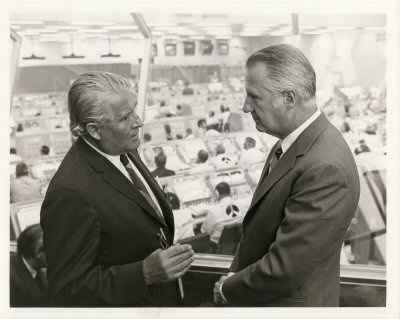
September 1969: Vice President Spiro Agnew's Space Task Force submits three options for America's future goals in space:
1. An 8 to 10 billion dollar a year plan, to build an orbiting space station with a crew of 50, a manned Mars mission, and a reusable space shuttle to service the station and Mars mission.
2. An 8 billion dollar a year plan, for a mission to Mars, serviced by available boosters.
3. A 5.7 billion dollar a year plan, for a space station. serviced by a reusable space shuttle.
March 1970: The Nixon Administration announces that the president has decided to support the least ambitious of the three space program options presented by Agnew's Space Task Force: a reusable space shuttle. A further restriction is announced, that work on the space station will be delayed, until it is seen how well the development of the shuttle proceeds.
July 28, 1970: Von Braun loses his most influential ally, when Administrator Thomas O. Paine announces his resignation from NASA.
October 5, 1970: Following a request by the White House that certain allegations--the nature of which have never been revealed--against von Braun be investigated, an internal letter of authorization for the scientist to be interviewed is issued. An excerpt:
The Bureau conducted applicant investigations on von Braun in 1948 and 1961 . . . . In 1970 it was decided to invite von Braun to speak at FBI Communion Breakfast. In this regard, Mr. Tolson [assistant director of the FBI] commented "He is a phony," and the Director [J. Edgar Hoover] concurred. Despite this weakness in his character, our investigations have not indicated any disloyalty to the US.
November 4, 1970: The FBI interviews Von Braun in his office at NASA. Large sections of the subsequent report of the interview are classified 'secret' to this day, and it still unknown exactly what was being investigated. However, one intriguing passage in the report that was not redacted may give a hint: "In 1947, he was allowed to return to Germany and, while there, he married his present wife, who is also his cousin. They have been happily married for over twenty years, and since his marriage he has been a 'pretty good boy.' " The very next day, a report to the White House states that "he completely denied these allegations. He voluntarily furnished information concerning his activities, since coming to the United States, which would tend to discredit this allegation."
June 30, 1973: Von Braun clears out his desk and leaves NASA after having announced his retirement on June 10, 1973.
July 1, 1973: Von Braun becomes the vice president for engineering and development at Fairchild Industries in Germantown, Maryland.
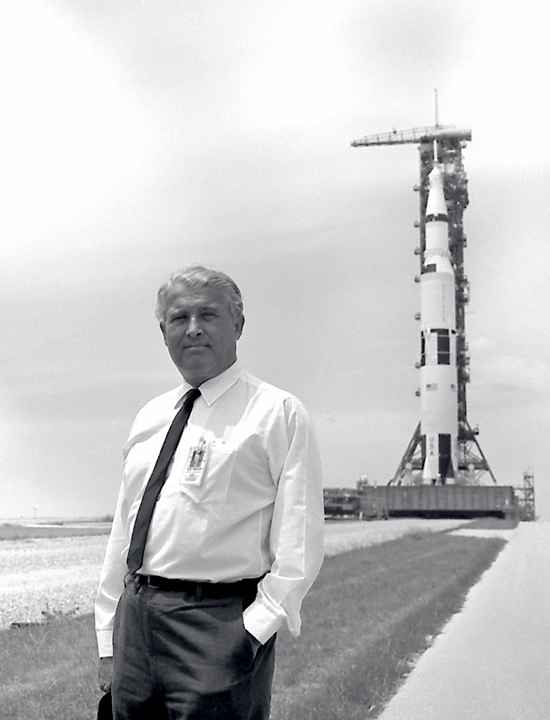
July 15, 1975: The last Saturn 1B is launched at Kennedy Space Center. Von Braun, who witnesses the launch, must have felt a good deal of pride that not one of his Saturn boosters had ever failed to complete its planned flight, a record unmatched by any other rocket design.
June 16, 1977: Wernher von Braun dies of pancreatic cancer in Alexandria, Virginia, at the age of 65. He is buried at the Ivy Hill Cemetery in Alexandria.

A few thoughts concerning this time-line:
The Cold War:
During the Nuremberg War Crimes Trials, the Soviet Union attempted to blame the Germans for one of their own war crimes; the Massacre at Katyn. It was a sensible—if cynical—strategy. After all, with all the other horrible, unthinkable crimes the Germans had committed, who would doubt their responsibility for this dirty deed as well?
If a low-life is arrested and charged with rape, it makes sense to peruse the unsolved rape cases to determine whether or not the suspect was involved in other sex crimes. That's just good police work. An over-zealous—or just plain lazy—law-enforcement type will sometimes attempt to clear out some of his old unsolved case files by attributing a measure of them to whoever happens to be within the reach of their radar at a given moment. Detectives like to solve cases, or at least to appear to have done so. Historians often seem particularly susceptible to this unfortunate tendency, as well. A lazy, over-zealous, or just plain partisan author can easily be tempted to perpetrate a similar error of generic attribution when dealing with highly controversial historical events involving iconic figures. This results in bad police work—and unreliable history.
Adolf Hitler is one such iconic figure, and the controversial events linked to the German Fuehrer are among the most important events of the last century: WW2, The Holocaust, the founding of Israel, and the Cold War. These highly-charged, historically significant events are all, to one degree or another, attributed directly to the actions and policies of Hitler. But are all these things "really" Hitler's 'fault?'
WW2 and The Holocaust are directly the responsibility of Adolf Hitler, without question. Were I a World Court Prosecutor, these would be the first two counts of my Indictment against Adolf Hitler. As a Prosecutor, you could not ask for a better case. Easy money. However, Hitler's "responsibility" for the creation of the State of Israel—which was and is not a crime, by the way—is tenuous, at best, and, were the full facts to be aired (Hitler had been dead quite a while before the act), it is doubtful a conviction on this point would be forthcoming from an impartial jury. (Who would have good reason to "blame" Hitler for the creation of Israel? Only unscrupulous—and wrong-headed—Hitler apologists, Deniers and anti-Semites.) As a responsible Prosecutor, I would not waste the Courts time with it.
Likewise, I contend that the Cold War was not Hitler's responsibility in any way. The Encarta World English Dictionary defines cold war as a "state of enmity without hostilities: a relationship between two people or groups that is unfriendly or hostile but does not involve actual fighting or military combat." By this definition, the Cold War between the USSR and the western democracies—represented mainly by Great Britain and the United States—began decades before the official start date.
US Federal Law states that the Cold War ran from September 2, 1945—the date the Japanese formally surrendered—to December 26, 1991—the date of the formal collapse of the Soviet Union. However, declarations embedded in US Federal Law are hardly superior to the normal debate and revision of historians and scholars intent on historical accuracy. D. F. Fleming, the author of the invaluable—and in some respects, definitive—two volume study The Cold War and its Origins, dates the beginning of the Cold War with the initial intervention of Western Forces in December, 1918. (Fleming's interpretation is obviously of more value than history defined by politicians.)
Hitler was serving on the Western Front at the time the Cold War began; he would not gain power—or any degree of international influence—for another 26 years. The Cold War began in the hearts and policies of Western Leaders much earlier. From the beginning of the consolidation of the Russian Revolution, the Western powers were disinclined to acquiesce in the power shift. They felt—with some justification—that this was a radical revolution along the lines of the French Revolution, and thus a grave danger to the status quo. The emphasis from "down with kings" to "down with capitalists" induced panic around the world, and immediate steps were taken in an attempt to contain the outbreak. Though there was not much that could be done against the Bolsheviks while the war still raged, the Western Powers—and Japan—occupied selected areas of Russia post-war in support of the counter-revolutionary White Russians. Most forces had evacuated by 1920, though the Japanese stayed until 1922, but trade and diplomatic opposition to the new regime continued unabated. Recognition of the USSR was hardly forthcoming, though it did eventually occur, piecemeal.
Hitler was NOT "responsible" for the Cold War, regardless of the start date. The most that can be said is that Hitler's policies and actions kept the Soviet regime in power for many decades longer than what was historically necessary. The system would most probably have disintegrated under its own internal contradictions upon the death of Stalin. The unwilling hostages trapped in the Satellite States of Eastern Europe allowed the Soviets to hang on long past their time. Hitler is responsible for that.
Ironically, Hitler was responsible for the only period of the Cold War to experience any meaningful thaw in relations. The USSR was still, to most intents and purposes, a pariah state in most Western minds when Hitler, in one stroke, legitimized the Soviet Union with that infamous Pact. Ironically, when Hitler later turned on Stalin, even Cold Warriors like Churchill were compelled by stark necessity to embrace the USSR as an Ally. Only a greater threat—Hitler—could have caused such an odd reversal. When asked how he could sanction such a turn of heart, Churchill replied to the effect that if Hitler were to invade Hell, he'd find some way to compliment Satan. Hardly a ringing endorsement of "Uncle Joe."
Hitler did, of course, affect the Cold War with his disingenuous policies; his ill-considered invasion of Russia caused the Western Powers to hold their noses and accept Stalin as an equal. This would NEVER have happened without Hitler's intervention. Once the East and West were united against him, Hitler tried every trick to cause the Alliance to crumble, to little actual effect. The end result of Barbarossa, and the later delay of the advance of the Normandy invasion forces by Hitler's so-called "Battle of the Bulge," was to put the two sides on a nearly equal footing as regards post-war geopolitics, conquered territory, and forward military deployment.
Setting the stage for the second half of the Cold War hardly equals "responsibility" for the entire event.
Occasionally, one of these so-called "Nazis," or one of their willing—or, perhaps, unwitting—compatriots, circling around the civilized settlements, spouts some silly nonsense propagating the myth of a supposed innate Nazi technological superiority, as demonstrated by Tiger Tanks, V-2 rockets, etc. "Where would we be without the advances pioneered by Hitler's scientists?," they ask.
Now, I am not suggesting that Nazi rocket technology had no effect on either post-war international politics or the evolution of technology. It was, in fact, the second most important technological battleground of the Cold War, second only to that of nuclear technology. The two would eventually merge to become the potential life-on-earth ending MAD (Mutual Assured Destruction) that is, in actuality, still with us (though no one talks about it much anymore). Rocket technology was a big deal, but nuclear technology was decisive, in the event; a war-ending weapon, that one. The Germans were not even close.
What the mutual-but-separate capture of Nazi rocket science did, in effect, was to establish a shared base line between the East and the West; a common point of departure. Each power started with basically the same technology, captured from defeated Germany. And each super-power developed and advanced that technology in roughly similar time frames; the first US jet fighter and the first MIG were very much the same aircraft. The Soviets would be ahead for awhile (Sputnik, etc.), the US would catch up (Independently Targeted LRICBM's, for example) and surpass for a bit, but their advances were chronologically pretty close, for the most part.
Before WW2, Allied scientists were certainly simultaneously working to develop an expertise in rocketry. The Soviets had an early success in deploying an early rocket-based weapons system on the battlefield; the Stalin Organs. And it's not as though the Nazis were the only ones to go with the idea of a ballistic missile; Goddard and others were advancing, but not at such a rate or with the short-term success that the brilliant (and well-funded) Germans were achieving (while stealing all of Goddard's copyrights in the process).
Had the Germans never built a single rocket or jet-engine, the technology would have emerged eventually regardless. The time-line would be different, of course. What drove the birth of the space-faring technology our age will ultimately be remembered for (though perhaps those few left to remember will have another perspective, depending on how it goes) was not so much that the Germans were ahead in that area in the early days, but due to the fact that the competition of the Cold War drove the super-powers to compete and excel.
In the immediate post-war world, nuclear technology was an American/UK monopoly for about 4-plus years (now there's a WMD that should, in a perfect world, never have been). Then the Russkies caught up and you know the rest. One can estimate from this representative example that, had one side or the other gained exclusive capture of Nazi rocket technology, the other side would have been urgently compelled to achieve the same level as quickly as possible, through any means necessary. Again, only the time-frame would be effected, not the ultimate development of the technology itself. So we land on the moon in 1975-or-so instead of cynically utilizing the tainted skills of men implicated in Crimes against Humanity to get there in 1969; so what? We still make a few footprints and invent Teflon and the like along the way. Just a matter of time, really.
The utilization of war criminals such as von Braun, etc., to score points and gain prestige during the Cold War is merely one of a long and painful string of unfortunate acts perpetrated by my own government: unlawful acts of cynicism to which I take strong exception. Von Braun should have been convicted, not treated like a celebrity.
The products actually produced by Hitler's scientists were militarily insignificant in relation to the immediate need of the German forces desperately engaged in a fight for their Voelkish goals. None of Hitler's wonder weapons, in the face of their aesthetic superiority—and despite their possible potential—proved at all useful to the average soldier or sailor. Hitler, the World War 1 "common soldier," in the end tragically let down his own soldiers in a way that history will never forget, and thinking, feeling Germans should never forgive.
The V-1 and V-2 were morally indefensible and militarily insignificant. The only effect they ever had on an actual battle was that the Allied command temporarily shifted focus, to an extent, toward taking the weapons' cross-Channel launch areas from the Germans shortly after D-Day. The steel and other strategic materials misused in constructing Hitler's vengeance weapons would have been of far greater use as U-boats (another of the few areas where the Nazis were more advanced) or armor or night fighters (ask the survivors of Berlin or Dresden which they'd have preferred) or long-range bombers, etc. The V-weapons were ultimately just another of Hitler's spectacular blunders, despite the technological pride inherent in advanced—but impractical—weapons systems.
The weapons delivered by Nazi scientists, almost without exception, were far less useful militarily than those advances the Allies created; advances which actually impacted positively the war effort of Hitler's opponents. Allied superiority in signet (ULTRA, MAGIC), electronic warfare (SONAR, RADAR, etc.), even something as simple and decisive as Mulberry harbors, were much more useful in the field than systems of marginal practical use such as Tiger tanks, vengeance weapons, and other cutting-edge wastes of time. The Soviet T-34 tank, while not nearly as aesthetically pleasing as the developing Nazi armor, nevertheless won the battles.
The same could be said for the American JEEP. When the first advance units of the Americans and Soviets met on conquered German ground and popped open a bottle of bubbly by the Elbe, the Red Army representatives offered three toasts to the Americans: 1—to Josef Stalin, 2—to US President Roosevelt, 3—to the American JEEP. The Soviet soldiers loved them. No other forces anywhere had such a sturdy and reliable machine filling that crucial niche. The German version was, after all, a re-engineered VW bug, and its performance was pitiful in comparison.
Many on the extreme right often claim that Nazi technology was superior to that of the rest of the world. They imagine that it was more advanced and "visionary," and that that fact confirms some aspect or another of this whole racialist Aryan garbage they go on about. Without Nazi technology, they demand, where would the world be? Well, the world would have been nowhere near as capable of engineering impregnable bunkers or easily concealed cyanide capsules: that is plain. Fortunately, some creative 'inventions' of the Nazis never made it past the planning stage. The following document excerpt illustrates this point well:

March 13, 1946: From the Interrogation of the Chief Engineer of the Berlin Firm Topf and Sohne, Fritz Sander:
I decided to design and build a crematorium with a higher capacity. I completed this project for a new crematorium in November 1942—a crematorium for mass incineration—and I submitted this project to a State Patent Commission in Berlin. This crematorium was to be built on the conveyor belt principle, that is to say, the corpses would be brought to the incineration furnaces continuously. When the corpses were pushed into the furnaces, they would fall into a grate, then slide into the furnace to be incinerated. The corpses would serve at the same time as fuel for heating the furnaces. This patent could not then be approved by the Main Patent Office in Berlin because of its secrecy classification. The project file is registered in the Patent Office but the invention could not be patented in wartime.
"Advances" such as these should only be found in bad comic books and macabre fiction, not a patent office, where such blueprints were, indeed, subsequently located.










Click to join 3rdReichStudies
Disclaimer:The Propagander!™ includes diverse and controversial materials--such as excerpts from the writings of racists and anti-Semites--so that its readers can learn the nature and extent of hate and anti-Semitic discourse. It is our sincere belief that only the informed citizen can prevail over the ignorance of Racialist "thought." Far from approving these writings, The Propagander!™ condemns racism in all of its forms and manifestations.
Fair Use Notice: The Propagander!™ may contain copyrighted material the use of which has not always been specifically authorized by the copyright owner. We are making such material available in our efforts to advance understanding of historical, political, human rights, economic, democracy, scientific, environmental, and social justice issues, etc. We believe this constitutes a "fair use" of any such copyrighted material as provided for in section 107 of the US Copyright Law. In accordance with Title 17 U.S.C. Section 107, the material on this site is distributed without profit to those who have expressed a prior interest in receiving the included information for research and educational purposes. If you wish to use copyrighted material from this site for purposes of your own that go beyond 'fair use', you must obtain permission from the copyright owner.